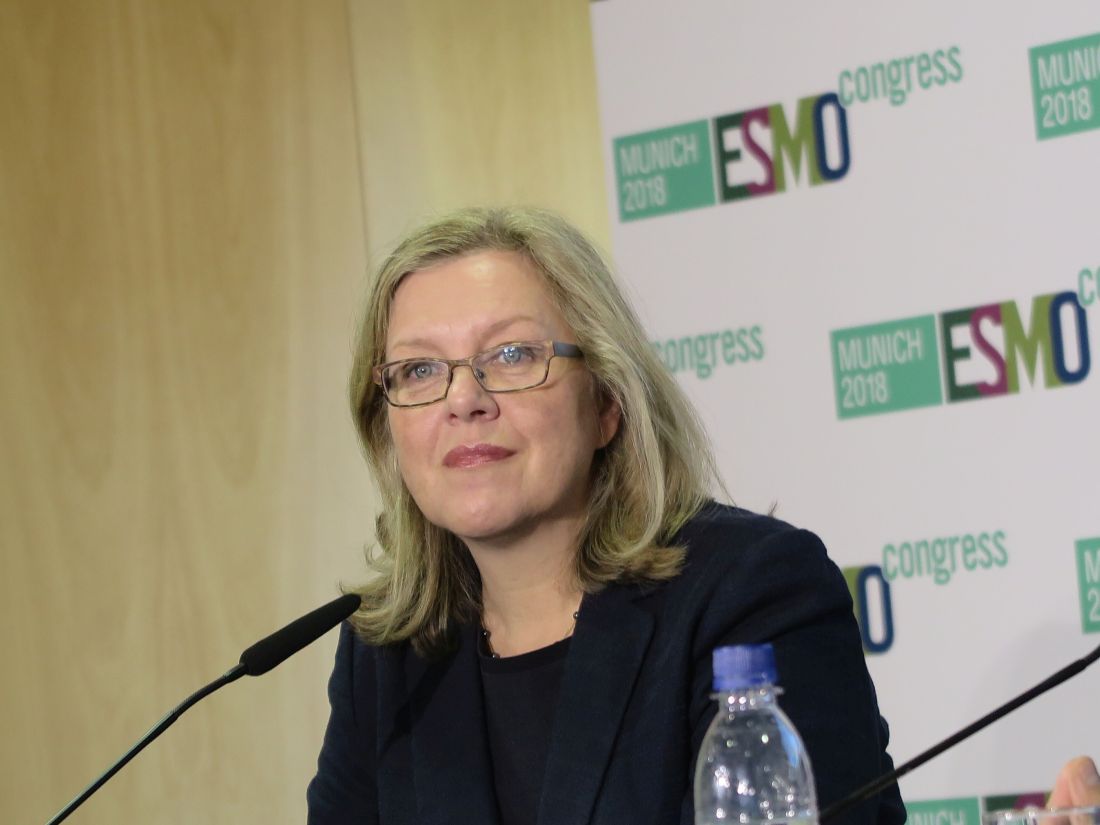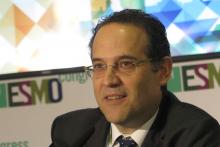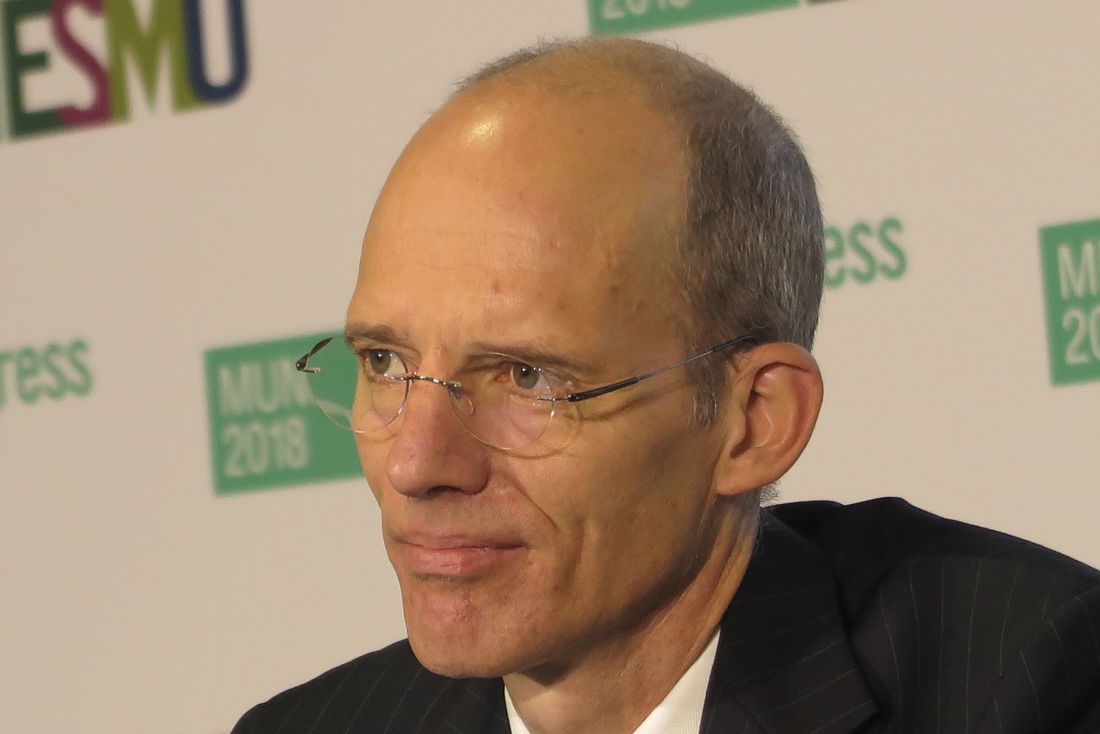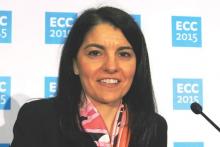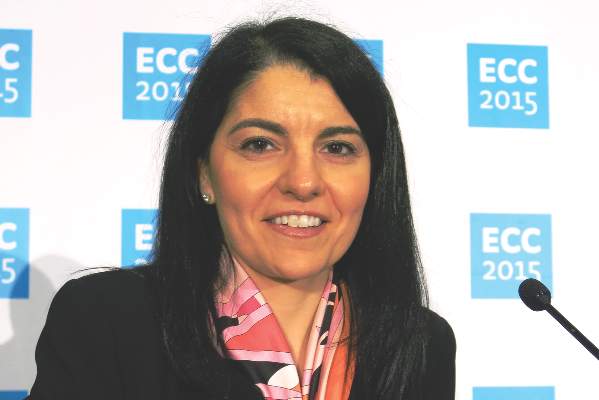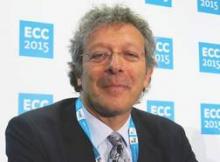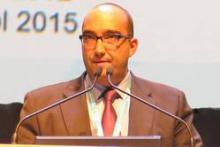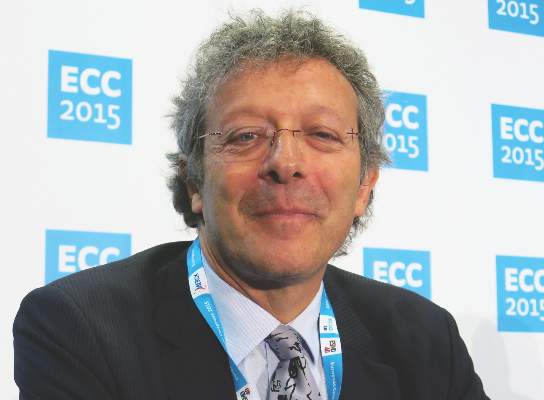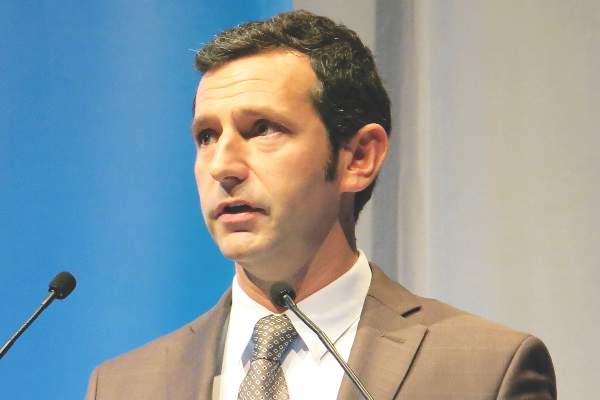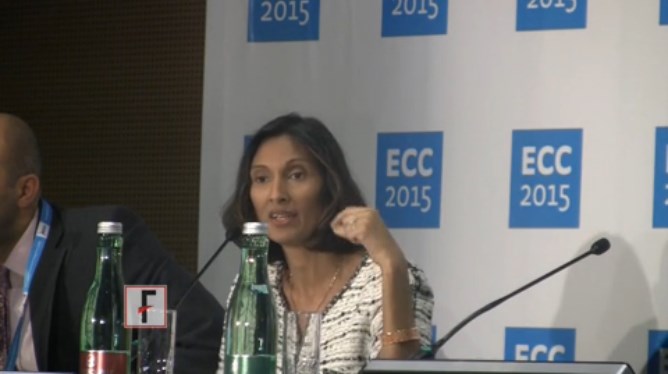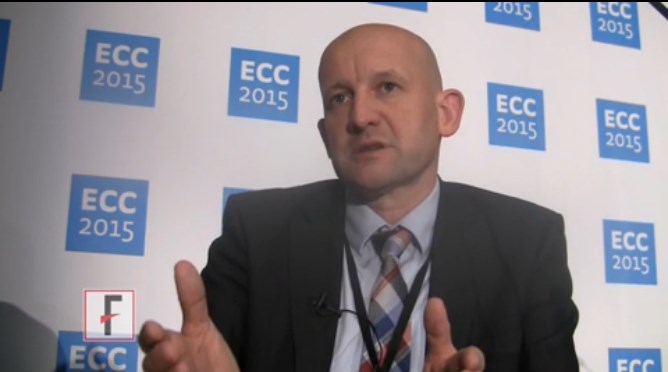User login
ECCO 18 - 40th ESMO European Cancer Congress
Pembrolizumab extends survival of head and neck cancer
MUNICH – In patients with recurrent or metastatic head and neck squamous cell carcinoma expressing programmed death ligand-1 (PDL-1), the immune checkpoint inhibitor pembrolizumab alone or in combination with chemotherapy improved overall survival, compared with the EXTREME chemotherapy regimen, reported investigators in the Keynote 048 trial.
Overall survival (OS) among patients with a PD-L1 combined positive score (CPS) of 20 or greater treated with pembrolizumab (Keytruda) monotherapy was 14.9 months compared with 10.7 months for patients treated with the EXTREME regimen, a combination of cetuximab (Erbitux), carboplatin or cisplatin, and 5-fluorouracil.
A similar overall survival benefit was seen in patients with a CPS of 1 or greater, and in the total population of patients treated with pembrolizumab plus chemotherapy followed by pembrolizumab maintenance compared with EXTREME chemotherapy, Barbara Burtness, MD, of Yale Cancer Center, New Haven, Conn.
There were no differences in response rates between either pembrolizumab monotherapy or in combination compared with chemotherapy alone, but responses were more durable with the checkpoint inhibitor than with chemotherapy.
“Pembrolizumab alone and pembrolizumab given with platinum and 5-fluorouracil should represent new standards of care for the first-line treatment of metastatic head and neck carcinoma. Immune checkpoint monotherapy with pembrolizumab allows patients to live longer and has a better safety profile than the previous standard for those patients whose tumors express PD-L1,” she said at a briefing prior to her presentation of the data in a presidential symposium at the European Society for Medical Oncology Congress.
“This is the first time since 10 years that we show an improvement in survival for this group of patients,” said Jean-Pascal Machiels, MD, of University Clinic Saint-Luc, Brussels, the invited discussant for the briefing and the symposium.
The CPS is a ratio of PD-L1-positive tumor cells, lymphocytes, and macrophages to the total numbers of cells counted multiplied by 100. The investigators looked at progression-free survival (PFS) and OS in three cohorts of patients with squamous cell carcinomas of the oropharynx, oral cavity, hypopharynx, or larynx that were recurrent or metastatic and were incurable by local therapies. They compared pembrolizumab monotherapy with the EXTREME regimen, and pembrolizumab plus chemotherapy (as described in the following paragraph) with EXTREME.
A total of 882 patients were enrolled and stratified by PD-L1 expression (on 50% or greater of tumor cells, or less than 50%), p16 positive or negative status in the oropharynx, and Eastern Cooperative Oncology Group performance status of 0 or 1. The patients were then randomly assigned on a 1:1:1 basis to either pembrolizumab monotherapy at 200 mg every 3 weeks for up to 35 cycles, pembrolizumab plus a standard chemotherapy regimen (carboplatin to an area-under-the curve [AUC] of 5 or cisplatin 100 mg/m2 plus 5-FU 1000 mg/m2 per day for 4 days for six cycles, followed by pembrolizumab maintenance for up to 35 cycles or EXTREME (cetuximab at a loading dose of 400 mg/m2 followed by 250 mg/m2 once weekly plus the chemotherapy regimen described above, followed by maintenance cetuximab).
Pembrolizumab monotherapy vs. EXTREME
For the coprimary endpoint of OS in the CPS 20 or greater population, pembrolizumab was associated with significantly better survival than EXTREME at both the 12- and 24-month time points (56.9% vs. 44.9%, and 38.3% vs. 22,1%, respectively). After a minimum follow-up of 17 months, the median OS was 14.9 months with pembrolizumab, vs. 10.7 months for EXTREME. The hazard ratio (HR) for death with pembrolizumab was 0.61 (P = .0007).
The median OS in the CPS 1 or greater population was 12.3 months and 10.3 months, respectively (HR 0.78, P = .0086).
There were no differences between the arms in PFS, however, either in the CPS 20 or greater or CPS 1 or greater populations.
Although, as noted, response rates did not differ between the groups, the median duration of response was 20.9 months with pembrolizumab in both the CPS 20 and CPS 1 populations, compared with 4.2 and 4.5 months, respectively, for EXTREME.
Treatment-related adverse events of any grade occurred in 58% of patients in the monotherapy arm, vs. 96.9% in the EXTREME arm. Fatal adverse events occurred in 1% vs. 2.8%, and events leading to drug discontinuation occurred in 4.7% vs. 19.9%, respectively. There were more immune-mediated events in the pembrolizumab arm, including one death (from pneumonitis) vs. no deaths from immune-related causes in the EXTREME arm.
Pembrolizumab plus chemo vs. EXTREME
The combination of pembrolizumab was also superior to EXTREME in the total population, with 12- and 24-month OS rates of 53% vs. 43.9%, and 29% vs. 18.7%, respectively. The median OS was 13 months with the pembrolizumab/chemo combination, vs. 10.7 months for EXTREME, translating into an HR of 0.77 (P = .0034). In this analysis as well as in the pembrolizumab monotherapy combination, there was no difference in PFS or response rates, but responses in the pembrolizumab arm were more durable.
In this comparison, treatment-related adverse events were generally similar between the groups, although there were 10 treatment-related deaths with pembrolizumab, compared with eight in the EXTREME arm.
There was one immune-related death, from pneumonitis, in the pembrolizumab arm, vs. none in the EXTREME arm. Hypothyroidism, pneumonitis, hyperthyroidism and colitis were more frequent with pembrolizumab, whereas infusion reactions and severe skin reactions were more frequent with EXTREME.
“There are further analyses of biomarker and clinical predictors that will be forthcoming from this study, and these may eventually optimally guide the choice of whether to administer pembrolizumab alone or in the novel combination, Dr. Burtness said at the briefing.
“What’s extremely important also is that for a subgroup of patients with high expression of PD-L1, we can probably remove the cisplatin and have a good outcome with immunotherapy alone,” Dr. Machiels said.
He said that more work needs to be done to determine which patients are most likely to benefit from immunotherapy in the recurrent/metastatic setting, and “we have to see how we can now bring this active drug to the curative treatment of the patient, in combination with chemoradiation.”
The study was funded by Merck Sharp & Dohme. Dr. Burtness disclosed being and advisory board member and receiving travel expenses from MSD and others. Dr. Machiels disclosed speaker honoraria, travel expenses, and an uncompensated advisory role with MSD.
SOURCE: Burtness B et al. ESMO 2018. Abstract LBA8_PR.
MUNICH – In patients with recurrent or metastatic head and neck squamous cell carcinoma expressing programmed death ligand-1 (PDL-1), the immune checkpoint inhibitor pembrolizumab alone or in combination with chemotherapy improved overall survival, compared with the EXTREME chemotherapy regimen, reported investigators in the Keynote 048 trial.
Overall survival (OS) among patients with a PD-L1 combined positive score (CPS) of 20 or greater treated with pembrolizumab (Keytruda) monotherapy was 14.9 months compared with 10.7 months for patients treated with the EXTREME regimen, a combination of cetuximab (Erbitux), carboplatin or cisplatin, and 5-fluorouracil.
A similar overall survival benefit was seen in patients with a CPS of 1 or greater, and in the total population of patients treated with pembrolizumab plus chemotherapy followed by pembrolizumab maintenance compared with EXTREME chemotherapy, Barbara Burtness, MD, of Yale Cancer Center, New Haven, Conn.
There were no differences in response rates between either pembrolizumab monotherapy or in combination compared with chemotherapy alone, but responses were more durable with the checkpoint inhibitor than with chemotherapy.
“Pembrolizumab alone and pembrolizumab given with platinum and 5-fluorouracil should represent new standards of care for the first-line treatment of metastatic head and neck carcinoma. Immune checkpoint monotherapy with pembrolizumab allows patients to live longer and has a better safety profile than the previous standard for those patients whose tumors express PD-L1,” she said at a briefing prior to her presentation of the data in a presidential symposium at the European Society for Medical Oncology Congress.
“This is the first time since 10 years that we show an improvement in survival for this group of patients,” said Jean-Pascal Machiels, MD, of University Clinic Saint-Luc, Brussels, the invited discussant for the briefing and the symposium.
The CPS is a ratio of PD-L1-positive tumor cells, lymphocytes, and macrophages to the total numbers of cells counted multiplied by 100. The investigators looked at progression-free survival (PFS) and OS in three cohorts of patients with squamous cell carcinomas of the oropharynx, oral cavity, hypopharynx, or larynx that were recurrent or metastatic and were incurable by local therapies. They compared pembrolizumab monotherapy with the EXTREME regimen, and pembrolizumab plus chemotherapy (as described in the following paragraph) with EXTREME.
A total of 882 patients were enrolled and stratified by PD-L1 expression (on 50% or greater of tumor cells, or less than 50%), p16 positive or negative status in the oropharynx, and Eastern Cooperative Oncology Group performance status of 0 or 1. The patients were then randomly assigned on a 1:1:1 basis to either pembrolizumab monotherapy at 200 mg every 3 weeks for up to 35 cycles, pembrolizumab plus a standard chemotherapy regimen (carboplatin to an area-under-the curve [AUC] of 5 or cisplatin 100 mg/m2 plus 5-FU 1000 mg/m2 per day for 4 days for six cycles, followed by pembrolizumab maintenance for up to 35 cycles or EXTREME (cetuximab at a loading dose of 400 mg/m2 followed by 250 mg/m2 once weekly plus the chemotherapy regimen described above, followed by maintenance cetuximab).
Pembrolizumab monotherapy vs. EXTREME
For the coprimary endpoint of OS in the CPS 20 or greater population, pembrolizumab was associated with significantly better survival than EXTREME at both the 12- and 24-month time points (56.9% vs. 44.9%, and 38.3% vs. 22,1%, respectively). After a minimum follow-up of 17 months, the median OS was 14.9 months with pembrolizumab, vs. 10.7 months for EXTREME. The hazard ratio (HR) for death with pembrolizumab was 0.61 (P = .0007).
The median OS in the CPS 1 or greater population was 12.3 months and 10.3 months, respectively (HR 0.78, P = .0086).
There were no differences between the arms in PFS, however, either in the CPS 20 or greater or CPS 1 or greater populations.
Although, as noted, response rates did not differ between the groups, the median duration of response was 20.9 months with pembrolizumab in both the CPS 20 and CPS 1 populations, compared with 4.2 and 4.5 months, respectively, for EXTREME.
Treatment-related adverse events of any grade occurred in 58% of patients in the monotherapy arm, vs. 96.9% in the EXTREME arm. Fatal adverse events occurred in 1% vs. 2.8%, and events leading to drug discontinuation occurred in 4.7% vs. 19.9%, respectively. There were more immune-mediated events in the pembrolizumab arm, including one death (from pneumonitis) vs. no deaths from immune-related causes in the EXTREME arm.
Pembrolizumab plus chemo vs. EXTREME
The combination of pembrolizumab was also superior to EXTREME in the total population, with 12- and 24-month OS rates of 53% vs. 43.9%, and 29% vs. 18.7%, respectively. The median OS was 13 months with the pembrolizumab/chemo combination, vs. 10.7 months for EXTREME, translating into an HR of 0.77 (P = .0034). In this analysis as well as in the pembrolizumab monotherapy combination, there was no difference in PFS or response rates, but responses in the pembrolizumab arm were more durable.
In this comparison, treatment-related adverse events were generally similar between the groups, although there were 10 treatment-related deaths with pembrolizumab, compared with eight in the EXTREME arm.
There was one immune-related death, from pneumonitis, in the pembrolizumab arm, vs. none in the EXTREME arm. Hypothyroidism, pneumonitis, hyperthyroidism and colitis were more frequent with pembrolizumab, whereas infusion reactions and severe skin reactions were more frequent with EXTREME.
“There are further analyses of biomarker and clinical predictors that will be forthcoming from this study, and these may eventually optimally guide the choice of whether to administer pembrolizumab alone or in the novel combination, Dr. Burtness said at the briefing.
“What’s extremely important also is that for a subgroup of patients with high expression of PD-L1, we can probably remove the cisplatin and have a good outcome with immunotherapy alone,” Dr. Machiels said.
He said that more work needs to be done to determine which patients are most likely to benefit from immunotherapy in the recurrent/metastatic setting, and “we have to see how we can now bring this active drug to the curative treatment of the patient, in combination with chemoradiation.”
The study was funded by Merck Sharp & Dohme. Dr. Burtness disclosed being and advisory board member and receiving travel expenses from MSD and others. Dr. Machiels disclosed speaker honoraria, travel expenses, and an uncompensated advisory role with MSD.
SOURCE: Burtness B et al. ESMO 2018. Abstract LBA8_PR.
MUNICH – In patients with recurrent or metastatic head and neck squamous cell carcinoma expressing programmed death ligand-1 (PDL-1), the immune checkpoint inhibitor pembrolizumab alone or in combination with chemotherapy improved overall survival, compared with the EXTREME chemotherapy regimen, reported investigators in the Keynote 048 trial.
Overall survival (OS) among patients with a PD-L1 combined positive score (CPS) of 20 or greater treated with pembrolizumab (Keytruda) monotherapy was 14.9 months compared with 10.7 months for patients treated with the EXTREME regimen, a combination of cetuximab (Erbitux), carboplatin or cisplatin, and 5-fluorouracil.
A similar overall survival benefit was seen in patients with a CPS of 1 or greater, and in the total population of patients treated with pembrolizumab plus chemotherapy followed by pembrolizumab maintenance compared with EXTREME chemotherapy, Barbara Burtness, MD, of Yale Cancer Center, New Haven, Conn.
There were no differences in response rates between either pembrolizumab monotherapy or in combination compared with chemotherapy alone, but responses were more durable with the checkpoint inhibitor than with chemotherapy.
“Pembrolizumab alone and pembrolizumab given with platinum and 5-fluorouracil should represent new standards of care for the first-line treatment of metastatic head and neck carcinoma. Immune checkpoint monotherapy with pembrolizumab allows patients to live longer and has a better safety profile than the previous standard for those patients whose tumors express PD-L1,” she said at a briefing prior to her presentation of the data in a presidential symposium at the European Society for Medical Oncology Congress.
“This is the first time since 10 years that we show an improvement in survival for this group of patients,” said Jean-Pascal Machiels, MD, of University Clinic Saint-Luc, Brussels, the invited discussant for the briefing and the symposium.
The CPS is a ratio of PD-L1-positive tumor cells, lymphocytes, and macrophages to the total numbers of cells counted multiplied by 100. The investigators looked at progression-free survival (PFS) and OS in three cohorts of patients with squamous cell carcinomas of the oropharynx, oral cavity, hypopharynx, or larynx that were recurrent or metastatic and were incurable by local therapies. They compared pembrolizumab monotherapy with the EXTREME regimen, and pembrolizumab plus chemotherapy (as described in the following paragraph) with EXTREME.
A total of 882 patients were enrolled and stratified by PD-L1 expression (on 50% or greater of tumor cells, or less than 50%), p16 positive or negative status in the oropharynx, and Eastern Cooperative Oncology Group performance status of 0 or 1. The patients were then randomly assigned on a 1:1:1 basis to either pembrolizumab monotherapy at 200 mg every 3 weeks for up to 35 cycles, pembrolizumab plus a standard chemotherapy regimen (carboplatin to an area-under-the curve [AUC] of 5 or cisplatin 100 mg/m2 plus 5-FU 1000 mg/m2 per day for 4 days for six cycles, followed by pembrolizumab maintenance for up to 35 cycles or EXTREME (cetuximab at a loading dose of 400 mg/m2 followed by 250 mg/m2 once weekly plus the chemotherapy regimen described above, followed by maintenance cetuximab).
Pembrolizumab monotherapy vs. EXTREME
For the coprimary endpoint of OS in the CPS 20 or greater population, pembrolizumab was associated with significantly better survival than EXTREME at both the 12- and 24-month time points (56.9% vs. 44.9%, and 38.3% vs. 22,1%, respectively). After a minimum follow-up of 17 months, the median OS was 14.9 months with pembrolizumab, vs. 10.7 months for EXTREME. The hazard ratio (HR) for death with pembrolizumab was 0.61 (P = .0007).
The median OS in the CPS 1 or greater population was 12.3 months and 10.3 months, respectively (HR 0.78, P = .0086).
There were no differences between the arms in PFS, however, either in the CPS 20 or greater or CPS 1 or greater populations.
Although, as noted, response rates did not differ between the groups, the median duration of response was 20.9 months with pembrolizumab in both the CPS 20 and CPS 1 populations, compared with 4.2 and 4.5 months, respectively, for EXTREME.
Treatment-related adverse events of any grade occurred in 58% of patients in the monotherapy arm, vs. 96.9% in the EXTREME arm. Fatal adverse events occurred in 1% vs. 2.8%, and events leading to drug discontinuation occurred in 4.7% vs. 19.9%, respectively. There were more immune-mediated events in the pembrolizumab arm, including one death (from pneumonitis) vs. no deaths from immune-related causes in the EXTREME arm.
Pembrolizumab plus chemo vs. EXTREME
The combination of pembrolizumab was also superior to EXTREME in the total population, with 12- and 24-month OS rates of 53% vs. 43.9%, and 29% vs. 18.7%, respectively. The median OS was 13 months with the pembrolizumab/chemo combination, vs. 10.7 months for EXTREME, translating into an HR of 0.77 (P = .0034). In this analysis as well as in the pembrolizumab monotherapy combination, there was no difference in PFS or response rates, but responses in the pembrolizumab arm were more durable.
In this comparison, treatment-related adverse events were generally similar between the groups, although there were 10 treatment-related deaths with pembrolizumab, compared with eight in the EXTREME arm.
There was one immune-related death, from pneumonitis, in the pembrolizumab arm, vs. none in the EXTREME arm. Hypothyroidism, pneumonitis, hyperthyroidism and colitis were more frequent with pembrolizumab, whereas infusion reactions and severe skin reactions were more frequent with EXTREME.
“There are further analyses of biomarker and clinical predictors that will be forthcoming from this study, and these may eventually optimally guide the choice of whether to administer pembrolizumab alone or in the novel combination, Dr. Burtness said at the briefing.
“What’s extremely important also is that for a subgroup of patients with high expression of PD-L1, we can probably remove the cisplatin and have a good outcome with immunotherapy alone,” Dr. Machiels said.
He said that more work needs to be done to determine which patients are most likely to benefit from immunotherapy in the recurrent/metastatic setting, and “we have to see how we can now bring this active drug to the curative treatment of the patient, in combination with chemoradiation.”
The study was funded by Merck Sharp & Dohme. Dr. Burtness disclosed being and advisory board member and receiving travel expenses from MSD and others. Dr. Machiels disclosed speaker honoraria, travel expenses, and an uncompensated advisory role with MSD.
SOURCE: Burtness B et al. ESMO 2018. Abstract LBA8_PR.
REPORTING FROM ESMO 2018
Key clinical point: Pembrolizumab alone or in combination with chemotherapy was associated with better overall survival of squamous cell head and neck cancer, compared with the EXTREME chemotherapy regimen.
Major finding: Overall survival among patients with a PD-L1 combined positive score of 20 or greater treated with pembrolizumab (Keytruda) monotherapy was 14.9 compared with 10.7 months for patients treated with the EXTREME regimen.
Study details: Randomized phase 3 trial of 882 patients with recurrent or metastatic squamous cell carcinoma of the head and neck.
Disclosures: The study was funded by Merck Sharp & Dohme. Dr. Burtness disclosed being and advisory board member and receiving travel expenses from MSD and others. Dr. Machiels disclosed speaker honoraria, travel expenses, and an uncompensated advisory role with MSD.
Source: Burtness B et al. ESMO 2018. Abstract LBA8_PR.
STAMPEDE: Radiation to prostate boosts survival of metastatic cancer
MUNICH – Radiotherapy of the primary tumor can improve overall survival in men with untreated metastatic adenocarcinoma of the prostate, a finding that suggests a possible life-extending role of radiotherapy in other metastatic tumor types, investigators in the STAMPEDE trial reported.
Among 2,061 men from the United Kingdom and Switzerland with previously untreated metastatic prostate cancer, there was no survival advantage to adding local radiation to standard drug therapy in the overall study population. But among men with low disease burden (local invasion of bone or lymphatics) radiation to the prostate plus standard of care was associated with a 32% improvement in overall survival compared with standard therapy alone, said Chris Parker, MD, from the Royal Marsden NHS Foundation Trust.
“Prostate radiotherapy is a simple treatment, it’s very well tolerated, and it’s widely available in any cancer center throughout the world,” Dr. Parker said in a briefing prior to his presentation in a presidential symposium at the European Society for Medical Oncology Congress.
The study was published online in the Lancet Oncology to coincide with the presentation.
Men who first present with metastatic prostate cancer account for about 10% of prostate cancer patients in the Western world, but may comprise as much as 60% of the prostate cancer population in some parts of Asia, noted briefing moderator and discussant Ignacio Duran, MD, from the Hospital Universitario Marques de Valdecilla, in Santander, Spain.
Prior to STAMPEDE, “we had never considered treating the local tumor in the context of wider-spread disease, and this is what the group of STAMPEDE really answered today with this study,” he said. “I think there is a substantial group of prostate cancer patients who might benefit from that. This opens the door to apply a new treatment that may have an impact in the life of these patients.”
The overarching goal of the STAMPEDE (Systemic Therapy in Advancing or Metastatic Prostate Cancer: Evaluation of Drug Efficacy) study is to assess novel approaches for men with hormone-naive prostate cancer.
For this aspect of the randomized, phase 3 trial, 2,061 men with newly diagnosed M1 prostate cancer were enrolled and randomly assigned to either androgen deprivation with or without docetaxel or to the same standard of care plus radiotherapy. Radiation was delivered in one of two schedules: 55 Gy delivered in 20 fractions over 4 weeks or 36 Gy in 6 fractions delivered over 6 weeks, started within 8 weeks of randomization or the start of docetaxel.
As noted before, death from any cause, the primary endpoint, was not significantly different between the study arms. But in a subgroup analysis by metastatic burden, the rate of 3-year overall survival in patients with low burden was 81% in the radiotherapy group, compared with 73% in the standard-of-care arm. The hazard ratio was 0.68 (P = .007) favoring radiation.
In contrast, the 3-year overall survival rate in the high metastatic burden arm (patients with four or more metastases to bone with at least one outside the axial skeleton and/or visceral metastases) was 53% with radiation, versus 54% without.
In all, 5% of patients in the radiotherapy arm had grade 3 or 4 adverse events during therapy, and 4% had postradiation adverse events.
Radiation was associated with small increases in the risk for bladder and bowel events, but these were generally “modest” in nature and were outweighed by the survival benefit, Dr. Parker said.
He noted that men with regional nodal invasion but not metastases were not included in the trial. “However, if prostate radiotherapy improves survival for men with distant metastases, we can be very confident that it would improve survival for men with regional nodal disease. There aren’t any trials addressing that question, and currently many of these men receive drug treatment alone. So going forward, prostate radiotherapy should be the standard treatment for these men as well.”
The concept of primary tumor irradiation may work for patients with other malignancies who have low burden (oligometastatic) disease, he added.
“Based on the findings of STAMPEDE, radiotherapy could be considered for patients with newly diagnosed oligometastatic prostate cancer, but further studies are needed to delineate the clinical implementation of such treatment,” commented R. Jeffrey Karnes, MD, from the Mayo Clinic in Rochester, Minnesota, and his colleagues, in an editorial accompanying the article in the Lancet Oncology.
The study is sponsored by the Medical Research Council of the United Kingdom. Dr. Parker disclosed research funding and personal fees from Bayer and personal fees from Advanced Accelerator Applications and Janssen Pharmaceuticals. Dr. Duran disclosed participation in compensated advisory boards for Roche and Bristol-Myers Squibb and speaker honoraria from Roche, Bristol-Myers Squibb, and Merck.
SOURCE: Parker C et al. ESMO 2018, Abstract LBA5_PR.
MUNICH – Radiotherapy of the primary tumor can improve overall survival in men with untreated metastatic adenocarcinoma of the prostate, a finding that suggests a possible life-extending role of radiotherapy in other metastatic tumor types, investigators in the STAMPEDE trial reported.
Among 2,061 men from the United Kingdom and Switzerland with previously untreated metastatic prostate cancer, there was no survival advantage to adding local radiation to standard drug therapy in the overall study population. But among men with low disease burden (local invasion of bone or lymphatics) radiation to the prostate plus standard of care was associated with a 32% improvement in overall survival compared with standard therapy alone, said Chris Parker, MD, from the Royal Marsden NHS Foundation Trust.
“Prostate radiotherapy is a simple treatment, it’s very well tolerated, and it’s widely available in any cancer center throughout the world,” Dr. Parker said in a briefing prior to his presentation in a presidential symposium at the European Society for Medical Oncology Congress.
The study was published online in the Lancet Oncology to coincide with the presentation.
Men who first present with metastatic prostate cancer account for about 10% of prostate cancer patients in the Western world, but may comprise as much as 60% of the prostate cancer population in some parts of Asia, noted briefing moderator and discussant Ignacio Duran, MD, from the Hospital Universitario Marques de Valdecilla, in Santander, Spain.
Prior to STAMPEDE, “we had never considered treating the local tumor in the context of wider-spread disease, and this is what the group of STAMPEDE really answered today with this study,” he said. “I think there is a substantial group of prostate cancer patients who might benefit from that. This opens the door to apply a new treatment that may have an impact in the life of these patients.”
The overarching goal of the STAMPEDE (Systemic Therapy in Advancing or Metastatic Prostate Cancer: Evaluation of Drug Efficacy) study is to assess novel approaches for men with hormone-naive prostate cancer.
For this aspect of the randomized, phase 3 trial, 2,061 men with newly diagnosed M1 prostate cancer were enrolled and randomly assigned to either androgen deprivation with or without docetaxel or to the same standard of care plus radiotherapy. Radiation was delivered in one of two schedules: 55 Gy delivered in 20 fractions over 4 weeks or 36 Gy in 6 fractions delivered over 6 weeks, started within 8 weeks of randomization or the start of docetaxel.
As noted before, death from any cause, the primary endpoint, was not significantly different between the study arms. But in a subgroup analysis by metastatic burden, the rate of 3-year overall survival in patients with low burden was 81% in the radiotherapy group, compared with 73% in the standard-of-care arm. The hazard ratio was 0.68 (P = .007) favoring radiation.
In contrast, the 3-year overall survival rate in the high metastatic burden arm (patients with four or more metastases to bone with at least one outside the axial skeleton and/or visceral metastases) was 53% with radiation, versus 54% without.
In all, 5% of patients in the radiotherapy arm had grade 3 or 4 adverse events during therapy, and 4% had postradiation adverse events.
Radiation was associated with small increases in the risk for bladder and bowel events, but these were generally “modest” in nature and were outweighed by the survival benefit, Dr. Parker said.
He noted that men with regional nodal invasion but not metastases were not included in the trial. “However, if prostate radiotherapy improves survival for men with distant metastases, we can be very confident that it would improve survival for men with regional nodal disease. There aren’t any trials addressing that question, and currently many of these men receive drug treatment alone. So going forward, prostate radiotherapy should be the standard treatment for these men as well.”
The concept of primary tumor irradiation may work for patients with other malignancies who have low burden (oligometastatic) disease, he added.
“Based on the findings of STAMPEDE, radiotherapy could be considered for patients with newly diagnosed oligometastatic prostate cancer, but further studies are needed to delineate the clinical implementation of such treatment,” commented R. Jeffrey Karnes, MD, from the Mayo Clinic in Rochester, Minnesota, and his colleagues, in an editorial accompanying the article in the Lancet Oncology.
The study is sponsored by the Medical Research Council of the United Kingdom. Dr. Parker disclosed research funding and personal fees from Bayer and personal fees from Advanced Accelerator Applications and Janssen Pharmaceuticals. Dr. Duran disclosed participation in compensated advisory boards for Roche and Bristol-Myers Squibb and speaker honoraria from Roche, Bristol-Myers Squibb, and Merck.
SOURCE: Parker C et al. ESMO 2018, Abstract LBA5_PR.
MUNICH – Radiotherapy of the primary tumor can improve overall survival in men with untreated metastatic adenocarcinoma of the prostate, a finding that suggests a possible life-extending role of radiotherapy in other metastatic tumor types, investigators in the STAMPEDE trial reported.
Among 2,061 men from the United Kingdom and Switzerland with previously untreated metastatic prostate cancer, there was no survival advantage to adding local radiation to standard drug therapy in the overall study population. But among men with low disease burden (local invasion of bone or lymphatics) radiation to the prostate plus standard of care was associated with a 32% improvement in overall survival compared with standard therapy alone, said Chris Parker, MD, from the Royal Marsden NHS Foundation Trust.
“Prostate radiotherapy is a simple treatment, it’s very well tolerated, and it’s widely available in any cancer center throughout the world,” Dr. Parker said in a briefing prior to his presentation in a presidential symposium at the European Society for Medical Oncology Congress.
The study was published online in the Lancet Oncology to coincide with the presentation.
Men who first present with metastatic prostate cancer account for about 10% of prostate cancer patients in the Western world, but may comprise as much as 60% of the prostate cancer population in some parts of Asia, noted briefing moderator and discussant Ignacio Duran, MD, from the Hospital Universitario Marques de Valdecilla, in Santander, Spain.
Prior to STAMPEDE, “we had never considered treating the local tumor in the context of wider-spread disease, and this is what the group of STAMPEDE really answered today with this study,” he said. “I think there is a substantial group of prostate cancer patients who might benefit from that. This opens the door to apply a new treatment that may have an impact in the life of these patients.”
The overarching goal of the STAMPEDE (Systemic Therapy in Advancing or Metastatic Prostate Cancer: Evaluation of Drug Efficacy) study is to assess novel approaches for men with hormone-naive prostate cancer.
For this aspect of the randomized, phase 3 trial, 2,061 men with newly diagnosed M1 prostate cancer were enrolled and randomly assigned to either androgen deprivation with or without docetaxel or to the same standard of care plus radiotherapy. Radiation was delivered in one of two schedules: 55 Gy delivered in 20 fractions over 4 weeks or 36 Gy in 6 fractions delivered over 6 weeks, started within 8 weeks of randomization or the start of docetaxel.
As noted before, death from any cause, the primary endpoint, was not significantly different between the study arms. But in a subgroup analysis by metastatic burden, the rate of 3-year overall survival in patients with low burden was 81% in the radiotherapy group, compared with 73% in the standard-of-care arm. The hazard ratio was 0.68 (P = .007) favoring radiation.
In contrast, the 3-year overall survival rate in the high metastatic burden arm (patients with four or more metastases to bone with at least one outside the axial skeleton and/or visceral metastases) was 53% with radiation, versus 54% without.
In all, 5% of patients in the radiotherapy arm had grade 3 or 4 adverse events during therapy, and 4% had postradiation adverse events.
Radiation was associated with small increases in the risk for bladder and bowel events, but these were generally “modest” in nature and were outweighed by the survival benefit, Dr. Parker said.
He noted that men with regional nodal invasion but not metastases were not included in the trial. “However, if prostate radiotherapy improves survival for men with distant metastases, we can be very confident that it would improve survival for men with regional nodal disease. There aren’t any trials addressing that question, and currently many of these men receive drug treatment alone. So going forward, prostate radiotherapy should be the standard treatment for these men as well.”
The concept of primary tumor irradiation may work for patients with other malignancies who have low burden (oligometastatic) disease, he added.
“Based on the findings of STAMPEDE, radiotherapy could be considered for patients with newly diagnosed oligometastatic prostate cancer, but further studies are needed to delineate the clinical implementation of such treatment,” commented R. Jeffrey Karnes, MD, from the Mayo Clinic in Rochester, Minnesota, and his colleagues, in an editorial accompanying the article in the Lancet Oncology.
The study is sponsored by the Medical Research Council of the United Kingdom. Dr. Parker disclosed research funding and personal fees from Bayer and personal fees from Advanced Accelerator Applications and Janssen Pharmaceuticals. Dr. Duran disclosed participation in compensated advisory boards for Roche and Bristol-Myers Squibb and speaker honoraria from Roche, Bristol-Myers Squibb, and Merck.
SOURCE: Parker C et al. ESMO 2018, Abstract LBA5_PR.
REPORTING FROM ESMO 2018
Key clinical point: Local radiation can improve survival of low-burden metastatic prostate cancer.
Major finding: In men with low-burden metastatic disease, the 3-year overall survival rate was 81% with radiation versus 73% without.
Study details: A prospective study of 2,061 men in a randomized, phase 3 trial exploring new therapeutic options for prostate cancer.
Disclosures: The study is sponsored by the Medical Research Council of the United Kingdom. Dr. Parker disclosed research funding and personal fees from Bayer and personal fees from Advanced Accelerator Applications and Janssen Pharmaceuticals. Dr. Duran disclosed participation in compensated advisory boards for Roche and Bristol-Myers Squibb and speaker honoraria from Roche, Bristol-Myers Squibb, and Merck.
Source: Parker C et al. ESMO 2018, Abstract LBA5_PR.
Evidence builds for aspirin’s benefit in GI cancers
VIENNA – Postdiagnosis aspirin use nearly doubled survival in patients with gastrointestinal cancers in a large study from the Netherlands.
After 5 years, 75% of daily low-dose–aspirin users were alive, compared with 42% of patients who were nonusers.
The beneficial effect of aspirin was seen for every gastrointestinal (GI) cancer (esophageal, stomach, hepatobiliary tract, colon, and rectal), except pancreatic cancer, Dr. Martine Frouws of Leiden (the Netherlands) University Medical Center reported at the European Society for Medical Oncology congress.
Many studies have suggested a role for regular aspirin use in reducing cancer incidence and mortality, particularly colorectal cancer, but this is the first time that survival data have been analyzed from patients with tumors in different GI locations.
“If aspirin can become a regular treatment for cancer, this can have a large impact on cancer survival and global health,” Dr. Frouws said in a press briefing.
The retrospective study involved 13,715 patients who had been diagnosed with a GI cancer between 1998 and 2011 in the population-based Eindhoven Cancer Registry and were linked to pharmacy data from PHARMO, the Institute for Drug Outcomes Research based in Utrecht.
Of these, 4,187 (30.5%) used aspirin before their cancer diagnosis, 1,143 (8.3%) were solely postdiagnosis users, and 8,385 (61.1%) did not take aspirin at all. Patients with prediagnosis aspirin use were excluded from the analysis.
Nearly half of the patients had colon cancer (43%), but a significant portion had rectal cancer (25%) and esophageal cancer (10.2%).
Median follow-up for all patients was 48.6 months, with 28% of patients surviving for at least 5 years.
The survival benefit with aspirin remained in patients with GI tumors after adjusting for sex, age, stage of cancer, surgery, radiotherapy, chemotherapy, and other medical conditions, Dr. Frouws reported.
“Medical research is focusing more and more on personalized medicine, but many personalized treatments are expensive and only useful in small populations,” she said in a statement. “We believe that our research shows quite the opposite – it demonstrates the considerable benefit of a cheap, well-established, and easily obtainable drug in a larger group of patients, while still targeting the treatment to a specific individual.”
Dr. Peter Naredi, scientific cochair of the cancer congress, who was not involved in the study, commented, “We have good evidence that the frequent use of aspirin in the population can prevent some cases of colorectal cancer. Now, Dr. Frouws and colleagues show that, in over 13,000 patients diagnosed with a gastrointestinal cancer, aspirin also improved survival compared with those who did not use it. With more and more data to support the beneficial role of aspirin, we must consider whether we should recommend it to a wider public.”
In its recent draft recommendations, the U.S. Preventive Services Task Force “recommends low-dose aspirin use for the primary prevention of cardiovascular disease and colorectal cancer in adults ages 50 to 59 years” who meet certain requirements and suggests aspirin use be individualized for those aged 60-69 years.
The authors and other researchers theorize that the antiplatelet effect of aspirin plays a key role in its anticancer effects. Circulating tumor cells are thought to hide from the immune system with the help of the platelets that surround them. Aspirin inhibits platelet function and therefore allows the immune system to better recognize and eliminate circulating tumor cells, Dr. Frouws explained.
The next step is to study the characteristics of tumors in patients for whom aspirin was beneficial to identify those who could profit from aspirin treatment in the future.
Because the study provides no information on the side effects of aspirin when used as a treatment for cancer, randomized trials have to be done to confirm the effect of aspirin on cancer, she said.
A slew of trials is currently underway to do just that, including the phase III, placebo-controlled Aspirin trial in the Netherlands studying the effects of aspirin 80 mg once daily on recurrence and survival in elderly patients with stage II and III colon cancer.
Other aspirin trials include the U.S. and Australian ASPREE trial in patients older than 65 years, CaPP3 in patients with Lynch syndrome, and the Asian ASCOLT trial for patients with Dukes C and high-risk Dukes B colorectal cancers.
In September, researchers at the Dana-Farber Cancer Institute and Brigham and Women’s Hospital received a $10 million award to study the impact of aspirin on breast cancer recurrence and mortality in the Aspirin for Breast Cancer (ABC) trial.
“Aspirin may serve as the magic bullet because it can target and prevent ischemic heart disease, cancer, and Alzheimer’s disease, the three major health catastrophes in the third millennium,” Dr. Nadir Arber, director of the Integrated Cancer Prevention Center, Tel Aviv Sourasky Medical Center, who was not involved in the research, said in a statement.
On Twitter @pwendl
VIENNA – Postdiagnosis aspirin use nearly doubled survival in patients with gastrointestinal cancers in a large study from the Netherlands.
After 5 years, 75% of daily low-dose–aspirin users were alive, compared with 42% of patients who were nonusers.
The beneficial effect of aspirin was seen for every gastrointestinal (GI) cancer (esophageal, stomach, hepatobiliary tract, colon, and rectal), except pancreatic cancer, Dr. Martine Frouws of Leiden (the Netherlands) University Medical Center reported at the European Society for Medical Oncology congress.
Many studies have suggested a role for regular aspirin use in reducing cancer incidence and mortality, particularly colorectal cancer, but this is the first time that survival data have been analyzed from patients with tumors in different GI locations.
“If aspirin can become a regular treatment for cancer, this can have a large impact on cancer survival and global health,” Dr. Frouws said in a press briefing.
The retrospective study involved 13,715 patients who had been diagnosed with a GI cancer between 1998 and 2011 in the population-based Eindhoven Cancer Registry and were linked to pharmacy data from PHARMO, the Institute for Drug Outcomes Research based in Utrecht.
Of these, 4,187 (30.5%) used aspirin before their cancer diagnosis, 1,143 (8.3%) were solely postdiagnosis users, and 8,385 (61.1%) did not take aspirin at all. Patients with prediagnosis aspirin use were excluded from the analysis.
Nearly half of the patients had colon cancer (43%), but a significant portion had rectal cancer (25%) and esophageal cancer (10.2%).
Median follow-up for all patients was 48.6 months, with 28% of patients surviving for at least 5 years.
The survival benefit with aspirin remained in patients with GI tumors after adjusting for sex, age, stage of cancer, surgery, radiotherapy, chemotherapy, and other medical conditions, Dr. Frouws reported.
“Medical research is focusing more and more on personalized medicine, but many personalized treatments are expensive and only useful in small populations,” she said in a statement. “We believe that our research shows quite the opposite – it demonstrates the considerable benefit of a cheap, well-established, and easily obtainable drug in a larger group of patients, while still targeting the treatment to a specific individual.”
Dr. Peter Naredi, scientific cochair of the cancer congress, who was not involved in the study, commented, “We have good evidence that the frequent use of aspirin in the population can prevent some cases of colorectal cancer. Now, Dr. Frouws and colleagues show that, in over 13,000 patients diagnosed with a gastrointestinal cancer, aspirin also improved survival compared with those who did not use it. With more and more data to support the beneficial role of aspirin, we must consider whether we should recommend it to a wider public.”
In its recent draft recommendations, the U.S. Preventive Services Task Force “recommends low-dose aspirin use for the primary prevention of cardiovascular disease and colorectal cancer in adults ages 50 to 59 years” who meet certain requirements and suggests aspirin use be individualized for those aged 60-69 years.
The authors and other researchers theorize that the antiplatelet effect of aspirin plays a key role in its anticancer effects. Circulating tumor cells are thought to hide from the immune system with the help of the platelets that surround them. Aspirin inhibits platelet function and therefore allows the immune system to better recognize and eliminate circulating tumor cells, Dr. Frouws explained.
The next step is to study the characteristics of tumors in patients for whom aspirin was beneficial to identify those who could profit from aspirin treatment in the future.
Because the study provides no information on the side effects of aspirin when used as a treatment for cancer, randomized trials have to be done to confirm the effect of aspirin on cancer, she said.
A slew of trials is currently underway to do just that, including the phase III, placebo-controlled Aspirin trial in the Netherlands studying the effects of aspirin 80 mg once daily on recurrence and survival in elderly patients with stage II and III colon cancer.
Other aspirin trials include the U.S. and Australian ASPREE trial in patients older than 65 years, CaPP3 in patients with Lynch syndrome, and the Asian ASCOLT trial for patients with Dukes C and high-risk Dukes B colorectal cancers.
In September, researchers at the Dana-Farber Cancer Institute and Brigham and Women’s Hospital received a $10 million award to study the impact of aspirin on breast cancer recurrence and mortality in the Aspirin for Breast Cancer (ABC) trial.
“Aspirin may serve as the magic bullet because it can target and prevent ischemic heart disease, cancer, and Alzheimer’s disease, the three major health catastrophes in the third millennium,” Dr. Nadir Arber, director of the Integrated Cancer Prevention Center, Tel Aviv Sourasky Medical Center, who was not involved in the research, said in a statement.
On Twitter @pwendl
VIENNA – Postdiagnosis aspirin use nearly doubled survival in patients with gastrointestinal cancers in a large study from the Netherlands.
After 5 years, 75% of daily low-dose–aspirin users were alive, compared with 42% of patients who were nonusers.
The beneficial effect of aspirin was seen for every gastrointestinal (GI) cancer (esophageal, stomach, hepatobiliary tract, colon, and rectal), except pancreatic cancer, Dr. Martine Frouws of Leiden (the Netherlands) University Medical Center reported at the European Society for Medical Oncology congress.
Many studies have suggested a role for regular aspirin use in reducing cancer incidence and mortality, particularly colorectal cancer, but this is the first time that survival data have been analyzed from patients with tumors in different GI locations.
“If aspirin can become a regular treatment for cancer, this can have a large impact on cancer survival and global health,” Dr. Frouws said in a press briefing.
The retrospective study involved 13,715 patients who had been diagnosed with a GI cancer between 1998 and 2011 in the population-based Eindhoven Cancer Registry and were linked to pharmacy data from PHARMO, the Institute for Drug Outcomes Research based in Utrecht.
Of these, 4,187 (30.5%) used aspirin before their cancer diagnosis, 1,143 (8.3%) were solely postdiagnosis users, and 8,385 (61.1%) did not take aspirin at all. Patients with prediagnosis aspirin use were excluded from the analysis.
Nearly half of the patients had colon cancer (43%), but a significant portion had rectal cancer (25%) and esophageal cancer (10.2%).
Median follow-up for all patients was 48.6 months, with 28% of patients surviving for at least 5 years.
The survival benefit with aspirin remained in patients with GI tumors after adjusting for sex, age, stage of cancer, surgery, radiotherapy, chemotherapy, and other medical conditions, Dr. Frouws reported.
“Medical research is focusing more and more on personalized medicine, but many personalized treatments are expensive and only useful in small populations,” she said in a statement. “We believe that our research shows quite the opposite – it demonstrates the considerable benefit of a cheap, well-established, and easily obtainable drug in a larger group of patients, while still targeting the treatment to a specific individual.”
Dr. Peter Naredi, scientific cochair of the cancer congress, who was not involved in the study, commented, “We have good evidence that the frequent use of aspirin in the population can prevent some cases of colorectal cancer. Now, Dr. Frouws and colleagues show that, in over 13,000 patients diagnosed with a gastrointestinal cancer, aspirin also improved survival compared with those who did not use it. With more and more data to support the beneficial role of aspirin, we must consider whether we should recommend it to a wider public.”
In its recent draft recommendations, the U.S. Preventive Services Task Force “recommends low-dose aspirin use for the primary prevention of cardiovascular disease and colorectal cancer in adults ages 50 to 59 years” who meet certain requirements and suggests aspirin use be individualized for those aged 60-69 years.
The authors and other researchers theorize that the antiplatelet effect of aspirin plays a key role in its anticancer effects. Circulating tumor cells are thought to hide from the immune system with the help of the platelets that surround them. Aspirin inhibits platelet function and therefore allows the immune system to better recognize and eliminate circulating tumor cells, Dr. Frouws explained.
The next step is to study the characteristics of tumors in patients for whom aspirin was beneficial to identify those who could profit from aspirin treatment in the future.
Because the study provides no information on the side effects of aspirin when used as a treatment for cancer, randomized trials have to be done to confirm the effect of aspirin on cancer, she said.
A slew of trials is currently underway to do just that, including the phase III, placebo-controlled Aspirin trial in the Netherlands studying the effects of aspirin 80 mg once daily on recurrence and survival in elderly patients with stage II and III colon cancer.
Other aspirin trials include the U.S. and Australian ASPREE trial in patients older than 65 years, CaPP3 in patients with Lynch syndrome, and the Asian ASCOLT trial for patients with Dukes C and high-risk Dukes B colorectal cancers.
In September, researchers at the Dana-Farber Cancer Institute and Brigham and Women’s Hospital received a $10 million award to study the impact of aspirin on breast cancer recurrence and mortality in the Aspirin for Breast Cancer (ABC) trial.
“Aspirin may serve as the magic bullet because it can target and prevent ischemic heart disease, cancer, and Alzheimer’s disease, the three major health catastrophes in the third millennium,” Dr. Nadir Arber, director of the Integrated Cancer Prevention Center, Tel Aviv Sourasky Medical Center, who was not involved in the research, said in a statement.
On Twitter @pwendl
AT THE EUROPEAN CANCER CONGRESS 2015
Key clinical point: Aspirin use initiated after diagnosis of gastrointestinal cancers is associated with higher survival rates.
Major finding: Five-year survival was 75% in postdiagnosis aspirin users vs. 42% in nonusers.
Data source: Retrospective study involving 13,715 patients with gastrointestinal tumors.
Disclosures: The authors reported having no significant disclosures.
Merkel cell carcinoma responds to immunotherapy
VIENNA – High response rates to pembrolizumab and to intratumoral delivery of plasmid interleukin-12 (IL-12) were observed among patients with advanced Merkel cell carcinoma (MCC), based on studies presented at the 2015 European Cancer Congress.
There is strong rationale for immunotherapy in MCC. For one thing, the Merkel cell polyomavirus, which is expressed in 80% of tumors, serves as a powerful antigen for stimulating an immune response. Secondly, MCC tumors often express the ligand for the programmed death protein (PD-1), creating an opportunity for PD-1 pathway blockade with PD-1 inhibitors such as pembrolizumab, according to the investigators.
Responses in 10 of 14 given pembrolizumab
Dr. Paul Nghiem of the University of Washington in Seattle, led an open-label, single-arm, multicenter phase II trial of pembrolizumab, which is approved for metastatic melanoma and which could become the first systemic therapy for unresectable or metastatic MCC (Abstract 22LBA).
In the study, which opened in January 2015, there are 24 evaluable patients treated with pembrolizumab 2 mg/kg every 3 weeks for up to 2 years. Fourteen had at least one posttreatment scan; 10 of these 14 patients (71%) have responded, 2 had complete responses. One patient had stable disease and three progressed.
“Responses were rapid, and appear more durable than we see with chemotherapy,” Dr. Nghiem said.
The drug was generally well tolerated, with an adverse event profile similar to what has been seen in melanoma. One patient experienced grade 4 myocarditis after one dose and one developed grade 4 transaminase elevation after two doses. Both improved after discontinuing pembrolizumab and starting corticosteroids.
“Strikingly, despite receiving only one or two doses, both patients had profound and ongoing responses to pembrolizumab,” Dr. Nghiem observed.
Many subjects had “profound shrinkage of tumor that has not rebounded,” he noted. “Pembrolizumab looks to be very favorable in terms of durability of response. With chemotherapy, at 90 days half of our patients have gone off treatment.”
The researchers are considering expanding the study population, and may include a chemotherapy-relapsed cohort. They are also analyzing biomarkers, and hope to evaluate response according to virus-positive versus virus-negative status.
Dr. Caroline Robert of the Institut Gustave Roussy in Villejuif, France, commented on the findings, first noting the difficulty of treating patients for whom there are no approved therapies. Median overall survival is less than 10 months, she said, and clinicians have lacked clinical trials to enroll patients.
“MCC patients represent a high medical need,” she said. Although the results with pembrolizumab are early, “they are very promising.”
Intratumoral plasmid IL-12
Dr. Shailender Bhatia of the University of Washington in Seattle, described a different immunotherapeutic approach in an MCC population (Abstract 504).
IL-12, which regulates adaptive type-1 immunity, has demonstrated antitumor efficacy in MCC but is associated with severe toxicities when administered systemically. Local IL-12 delivery to the tumor microenvironment “may provide adequate cytokine concentration in the vicinity of tumor antigens, and therefore improve efficacy while sparing systemic toxicity,” he said.
Intratumoral IL-12 plasmid DNA (pIL-12) injection with electroporation (which uses pulsed electricity to open pores in cell membranes) has shown antitumor activity in melanoma, and might also work in MCC, Dr. Bhatia and his colleagues hypothesized. The concept is one of promoting tumor inflammation and thereby a systemic antitumor immune response. This would be reflected, and measured, by increased IL-12 protein expression in the tumor microenvironment, which became this study’s primary endpoint.
“To the best of our knowledge, this study represents the first prospective clinical trial of immunotherapy in advanced MCC,” Dr. Bhatia noted.
Beginning in January 2012, the study enrolled 15 patients with MCC and superficial injectable tumors. Patients received injections of pIL-12 on days 1, 5, and 8; 2 weeks later, on day 22, their lesions were biopsied. The 3-person cohort with localized MCC (stage IIIb) then underwent definitive surgery and/or radiation therapy starting in week 4, while the 12 with distant metastatic disease (stage IV) could receive additional treatment cycles (maximum of 4) at least 6 weeks apart.
The treatment was well tolerated, with most adverse events – primarily pain and local inflammatory reaction – being mild and transient. No patients discontinued because of toxicity.
The primary endpoint, sustained local expression of IL-12 protein on day 22, was observed in 79% of patients. In paired biopsy samples, comparing baseline to day 22 levels, IL-12 protein expression increased by almost 2-fold to more than 3,000-fold.
In addition, enrichment of Merkel cell polyomavirus-specific CD8-positive T cells were found in the tumor infiltrating lymphocytes (TILs) of treated and distant tumors in some patients.
“Additionally, the pIL-12/electroporation treatment led to objective clinical responses in metastatic MCC,” Dr. Bhatia reported.
Among the three patients with locally advanced disease, one had a pathologic complete response and remains free of recurrence more than 6 months later. Another patient has been recurrence free for more than 3 years. The third patient was recurrence free for 9 months before developing progressive disease.
Among the 12 patients with metastatic disease, 3 responded to treatment and 1 achieved stable disease, while 8 (52%) progressed.
The injections led to regression not only of treated lesions, but also of clearly distinct noninjected MCC tumors. The proportion of treated lesions with major (more than 30%) regression was 44%. Among 10 patients with at least one distant lesion, 30% of noninjected distant lesions regressed.
“We believe this approach warrants further exploration in MCC, perhaps in combination with emerging systemic therapies, such as anti-PD-1/PD-L1 agents,” Dr. Bhatia said.
Dr. Nghiem and Dr. Bhatia had no relevant disclosures. In the IL-12 study, some investigators have financial relationships with OncoSec Medical, which manufactures the study drug.
VIENNA – High response rates to pembrolizumab and to intratumoral delivery of plasmid interleukin-12 (IL-12) were observed among patients with advanced Merkel cell carcinoma (MCC), based on studies presented at the 2015 European Cancer Congress.
There is strong rationale for immunotherapy in MCC. For one thing, the Merkel cell polyomavirus, which is expressed in 80% of tumors, serves as a powerful antigen for stimulating an immune response. Secondly, MCC tumors often express the ligand for the programmed death protein (PD-1), creating an opportunity for PD-1 pathway blockade with PD-1 inhibitors such as pembrolizumab, according to the investigators.
Responses in 10 of 14 given pembrolizumab
Dr. Paul Nghiem of the University of Washington in Seattle, led an open-label, single-arm, multicenter phase II trial of pembrolizumab, which is approved for metastatic melanoma and which could become the first systemic therapy for unresectable or metastatic MCC (Abstract 22LBA).
In the study, which opened in January 2015, there are 24 evaluable patients treated with pembrolizumab 2 mg/kg every 3 weeks for up to 2 years. Fourteen had at least one posttreatment scan; 10 of these 14 patients (71%) have responded, 2 had complete responses. One patient had stable disease and three progressed.
“Responses were rapid, and appear more durable than we see with chemotherapy,” Dr. Nghiem said.
The drug was generally well tolerated, with an adverse event profile similar to what has been seen in melanoma. One patient experienced grade 4 myocarditis after one dose and one developed grade 4 transaminase elevation after two doses. Both improved after discontinuing pembrolizumab and starting corticosteroids.
“Strikingly, despite receiving only one or two doses, both patients had profound and ongoing responses to pembrolizumab,” Dr. Nghiem observed.
Many subjects had “profound shrinkage of tumor that has not rebounded,” he noted. “Pembrolizumab looks to be very favorable in terms of durability of response. With chemotherapy, at 90 days half of our patients have gone off treatment.”
The researchers are considering expanding the study population, and may include a chemotherapy-relapsed cohort. They are also analyzing biomarkers, and hope to evaluate response according to virus-positive versus virus-negative status.
Dr. Caroline Robert of the Institut Gustave Roussy in Villejuif, France, commented on the findings, first noting the difficulty of treating patients for whom there are no approved therapies. Median overall survival is less than 10 months, she said, and clinicians have lacked clinical trials to enroll patients.
“MCC patients represent a high medical need,” she said. Although the results with pembrolizumab are early, “they are very promising.”
Intratumoral plasmid IL-12
Dr. Shailender Bhatia of the University of Washington in Seattle, described a different immunotherapeutic approach in an MCC population (Abstract 504).
IL-12, which regulates adaptive type-1 immunity, has demonstrated antitumor efficacy in MCC but is associated with severe toxicities when administered systemically. Local IL-12 delivery to the tumor microenvironment “may provide adequate cytokine concentration in the vicinity of tumor antigens, and therefore improve efficacy while sparing systemic toxicity,” he said.
Intratumoral IL-12 plasmid DNA (pIL-12) injection with electroporation (which uses pulsed electricity to open pores in cell membranes) has shown antitumor activity in melanoma, and might also work in MCC, Dr. Bhatia and his colleagues hypothesized. The concept is one of promoting tumor inflammation and thereby a systemic antitumor immune response. This would be reflected, and measured, by increased IL-12 protein expression in the tumor microenvironment, which became this study’s primary endpoint.
“To the best of our knowledge, this study represents the first prospective clinical trial of immunotherapy in advanced MCC,” Dr. Bhatia noted.
Beginning in January 2012, the study enrolled 15 patients with MCC and superficial injectable tumors. Patients received injections of pIL-12 on days 1, 5, and 8; 2 weeks later, on day 22, their lesions were biopsied. The 3-person cohort with localized MCC (stage IIIb) then underwent definitive surgery and/or radiation therapy starting in week 4, while the 12 with distant metastatic disease (stage IV) could receive additional treatment cycles (maximum of 4) at least 6 weeks apart.
The treatment was well tolerated, with most adverse events – primarily pain and local inflammatory reaction – being mild and transient. No patients discontinued because of toxicity.
The primary endpoint, sustained local expression of IL-12 protein on day 22, was observed in 79% of patients. In paired biopsy samples, comparing baseline to day 22 levels, IL-12 protein expression increased by almost 2-fold to more than 3,000-fold.
In addition, enrichment of Merkel cell polyomavirus-specific CD8-positive T cells were found in the tumor infiltrating lymphocytes (TILs) of treated and distant tumors in some patients.
“Additionally, the pIL-12/electroporation treatment led to objective clinical responses in metastatic MCC,” Dr. Bhatia reported.
Among the three patients with locally advanced disease, one had a pathologic complete response and remains free of recurrence more than 6 months later. Another patient has been recurrence free for more than 3 years. The third patient was recurrence free for 9 months before developing progressive disease.
Among the 12 patients with metastatic disease, 3 responded to treatment and 1 achieved stable disease, while 8 (52%) progressed.
The injections led to regression not only of treated lesions, but also of clearly distinct noninjected MCC tumors. The proportion of treated lesions with major (more than 30%) regression was 44%. Among 10 patients with at least one distant lesion, 30% of noninjected distant lesions regressed.
“We believe this approach warrants further exploration in MCC, perhaps in combination with emerging systemic therapies, such as anti-PD-1/PD-L1 agents,” Dr. Bhatia said.
Dr. Nghiem and Dr. Bhatia had no relevant disclosures. In the IL-12 study, some investigators have financial relationships with OncoSec Medical, which manufactures the study drug.
VIENNA – High response rates to pembrolizumab and to intratumoral delivery of plasmid interleukin-12 (IL-12) were observed among patients with advanced Merkel cell carcinoma (MCC), based on studies presented at the 2015 European Cancer Congress.
There is strong rationale for immunotherapy in MCC. For one thing, the Merkel cell polyomavirus, which is expressed in 80% of tumors, serves as a powerful antigen for stimulating an immune response. Secondly, MCC tumors often express the ligand for the programmed death protein (PD-1), creating an opportunity for PD-1 pathway blockade with PD-1 inhibitors such as pembrolizumab, according to the investigators.
Responses in 10 of 14 given pembrolizumab
Dr. Paul Nghiem of the University of Washington in Seattle, led an open-label, single-arm, multicenter phase II trial of pembrolizumab, which is approved for metastatic melanoma and which could become the first systemic therapy for unresectable or metastatic MCC (Abstract 22LBA).
In the study, which opened in January 2015, there are 24 evaluable patients treated with pembrolizumab 2 mg/kg every 3 weeks for up to 2 years. Fourteen had at least one posttreatment scan; 10 of these 14 patients (71%) have responded, 2 had complete responses. One patient had stable disease and three progressed.
“Responses were rapid, and appear more durable than we see with chemotherapy,” Dr. Nghiem said.
The drug was generally well tolerated, with an adverse event profile similar to what has been seen in melanoma. One patient experienced grade 4 myocarditis after one dose and one developed grade 4 transaminase elevation after two doses. Both improved after discontinuing pembrolizumab and starting corticosteroids.
“Strikingly, despite receiving only one or two doses, both patients had profound and ongoing responses to pembrolizumab,” Dr. Nghiem observed.
Many subjects had “profound shrinkage of tumor that has not rebounded,” he noted. “Pembrolizumab looks to be very favorable in terms of durability of response. With chemotherapy, at 90 days half of our patients have gone off treatment.”
The researchers are considering expanding the study population, and may include a chemotherapy-relapsed cohort. They are also analyzing biomarkers, and hope to evaluate response according to virus-positive versus virus-negative status.
Dr. Caroline Robert of the Institut Gustave Roussy in Villejuif, France, commented on the findings, first noting the difficulty of treating patients for whom there are no approved therapies. Median overall survival is less than 10 months, she said, and clinicians have lacked clinical trials to enroll patients.
“MCC patients represent a high medical need,” she said. Although the results with pembrolizumab are early, “they are very promising.”
Intratumoral plasmid IL-12
Dr. Shailender Bhatia of the University of Washington in Seattle, described a different immunotherapeutic approach in an MCC population (Abstract 504).
IL-12, which regulates adaptive type-1 immunity, has demonstrated antitumor efficacy in MCC but is associated with severe toxicities when administered systemically. Local IL-12 delivery to the tumor microenvironment “may provide adequate cytokine concentration in the vicinity of tumor antigens, and therefore improve efficacy while sparing systemic toxicity,” he said.
Intratumoral IL-12 plasmid DNA (pIL-12) injection with electroporation (which uses pulsed electricity to open pores in cell membranes) has shown antitumor activity in melanoma, and might also work in MCC, Dr. Bhatia and his colleagues hypothesized. The concept is one of promoting tumor inflammation and thereby a systemic antitumor immune response. This would be reflected, and measured, by increased IL-12 protein expression in the tumor microenvironment, which became this study’s primary endpoint.
“To the best of our knowledge, this study represents the first prospective clinical trial of immunotherapy in advanced MCC,” Dr. Bhatia noted.
Beginning in January 2012, the study enrolled 15 patients with MCC and superficial injectable tumors. Patients received injections of pIL-12 on days 1, 5, and 8; 2 weeks later, on day 22, their lesions were biopsied. The 3-person cohort with localized MCC (stage IIIb) then underwent definitive surgery and/or radiation therapy starting in week 4, while the 12 with distant metastatic disease (stage IV) could receive additional treatment cycles (maximum of 4) at least 6 weeks apart.
The treatment was well tolerated, with most adverse events – primarily pain and local inflammatory reaction – being mild and transient. No patients discontinued because of toxicity.
The primary endpoint, sustained local expression of IL-12 protein on day 22, was observed in 79% of patients. In paired biopsy samples, comparing baseline to day 22 levels, IL-12 protein expression increased by almost 2-fold to more than 3,000-fold.
In addition, enrichment of Merkel cell polyomavirus-specific CD8-positive T cells were found in the tumor infiltrating lymphocytes (TILs) of treated and distant tumors in some patients.
“Additionally, the pIL-12/electroporation treatment led to objective clinical responses in metastatic MCC,” Dr. Bhatia reported.
Among the three patients with locally advanced disease, one had a pathologic complete response and remains free of recurrence more than 6 months later. Another patient has been recurrence free for more than 3 years. The third patient was recurrence free for 9 months before developing progressive disease.
Among the 12 patients with metastatic disease, 3 responded to treatment and 1 achieved stable disease, while 8 (52%) progressed.
The injections led to regression not only of treated lesions, but also of clearly distinct noninjected MCC tumors. The proportion of treated lesions with major (more than 30%) regression was 44%. Among 10 patients with at least one distant lesion, 30% of noninjected distant lesions regressed.
“We believe this approach warrants further exploration in MCC, perhaps in combination with emerging systemic therapies, such as anti-PD-1/PD-L1 agents,” Dr. Bhatia said.
Dr. Nghiem and Dr. Bhatia had no relevant disclosures. In the IL-12 study, some investigators have financial relationships with OncoSec Medical, which manufactures the study drug.
AT THE EUROPEAN CANCER CONGRESS 2015
Key clinical point: Merkel cell carcinoma may respond well to immunotherapeutic approaches.
Major finding: Patients had robust and durable responses to the PD-1 inhibitor pembrolizumab and to intratumoral IL-12 injections.
Data source: Single-arm open label studies; pembrolizumab study included 24 patients. IL-2 study included 15 patients.
Disclosures: Dr. Nghiem reported no conflicts of interest. In the IL-12 study, some investigators have financial relationships with OncoSec Medical, which manufactures the study drug. Dr. Bhatia had no relevant disclosures.
Targeted therapy brings fresh hope for small-cell lung cancer treatment
VIENNA – Rovalpituzumab tesirine, an antibody drug conjugate that targets delta-like protein 3, produced responses in a range of patients with previously treated small-cell lung cancer in a phase I study.
Responses to rovalpituzumab tesirine (Rova-T) were higher and more durable in patients with tumors positive for DLL3, a protein previously shown to be over-expressed in about 70% of small-cell lung cancers (SCLCs).
“DLL3 may be the first predictive biomarker associated with treatment efficacy in small-cell lung cancer,” Dr. M. Catherine Pietanza of Memorial Sloan Kettering Cancer Center, New York City, said during a presidential session at the European Cancer Congress 2015.
While SCLC is initially sensitive to chemotherapy and radiation, resistance develops quickly. Topotecan (Hycamtin) is the only approved agent in the second-line setting. None are available in the third-line setting and outcomes remain dismal, with 5-year survival rates of 6%, she said.
The study enrolled 73 patients with recurrent or progressive SCLC after first- or second-line therapy and administered escalating doses of rovalpituzumab tesirine (0.05 mg/kg to 0.8 mg/kg) once every 3 weeks. Confirmed responses were observed at the 0.2-mg/kg, 0.3-mg/kg, and 0.4-mg/kg dose levels.
The maximum tolerated dose was 0.4 mg/kg, but continued dosing revealed cumulative toxicities, most often serosal effusions, Dr. Pietanza said. The agent was also found to have a prolonged half-life, prompting the researchers to proceed with rovalpituzumab tesirine 0.2 mg/kg every 3 weeks and 0.3 mg/kg every 6 weeks in the phase Ib expansion cohorts.
The patients median age was 61 years and 56% were male. Of the 49 tumor samples available for analysis, 71% were positive for high DLL3 expression using an H score cutoff of at least 180 on a scale of 300.
For all patients and at all dose levels, the overall response rate was 24% in the second-line setting, 20% in the third-line setting, 28% for those sensitive to first-line combination chemotherapy, and 16% for those refractory or resistant to chemotherapy, Dr. Pietanza reported.
For the DLL3-positive patients in the expansion cohorts, the overall response rate reached 64% for those sensitive to first-line chemotherapy, 44% in the second-line setting, 45% in the third-line setting, and 23% for those refractory or resistant to chemotherapy.
Importantly, responses were durable, Dr. Pietanza observed. At the 0.3 mg/kg 6-week dosing schedule, patients had ongoing responses 189 days after confirmatory CT scans and survival remains prolonged. For these reasons, the dose of 0.3 mg/kg every 6 weeks was chosen as the randomized phase II dose, she added.
Dr. Pietanza highlighted the benefits of rovalpituzumab tesirine by describing one patient who had a partial response to the first dose that continued, with a 51% reduction in tumor volume and a negative PET scan at 120 days. An adrenalectomy was performed at about 220 days due to ongoing response and disease presence only in the adrenal gland.
“Upon pathology review, there was a 95% treatment effect on the tumor,” she said. “When the adrenal gland was stained for Ki67, which is a marker of proliferative index, it was completely negative, noting and underscoring that possibly Rova-T affects tumor initiating cells.
“My patient remains alive with no evidence of disease over 1 year after first administration of Rova-T.”
The drug has a manageable safety profile, with unique reactions being pleural effusions and photosensitivity, she said.
Among 69 evaluable patients in the dose-escalation cohorts, the most common treatment-related adverse events of any grade were fatigue (28%), peripheral edema (17%), maculopapular rash (14%), thrombocytopenia (14%), pleural effusion (13%), and photosensitivity (12%), Dr. Pietanza said.
The most frequent grade 3/4 events were thrombocytopenia (9%), fatigue (6%), maculopapular rash (4%), and pleural effusion (4%).
“These results support biomarker-guided phase II studies,” she concluded.
Discussant Dr. Martin Reck, of the Lung Clinic Grosshansdorf (Germany), said, “We have seen very interesting results, perhaps the first targeted treatment in small-cell lung cancer. The data are very much superior to topotecan.”
More clinical data are needed, however, and the results must be put into perspective with the immunotherapies, where encouraging results have also been seen in SCLC, he said. The optimal treatment setting also has to be determined for rovalpituzumab tesirine, whether it is maintenance or perhaps a combination strategy.
Professor Peter Naredi, scientific cochair of the congress, said in a statement that the early results are “remarkable” in a malignancy where there has been no novel treatment options for years.
On Twitter @pwendl
VIENNA – Rovalpituzumab tesirine, an antibody drug conjugate that targets delta-like protein 3, produced responses in a range of patients with previously treated small-cell lung cancer in a phase I study.
Responses to rovalpituzumab tesirine (Rova-T) were higher and more durable in patients with tumors positive for DLL3, a protein previously shown to be over-expressed in about 70% of small-cell lung cancers (SCLCs).
“DLL3 may be the first predictive biomarker associated with treatment efficacy in small-cell lung cancer,” Dr. M. Catherine Pietanza of Memorial Sloan Kettering Cancer Center, New York City, said during a presidential session at the European Cancer Congress 2015.
While SCLC is initially sensitive to chemotherapy and radiation, resistance develops quickly. Topotecan (Hycamtin) is the only approved agent in the second-line setting. None are available in the third-line setting and outcomes remain dismal, with 5-year survival rates of 6%, she said.
The study enrolled 73 patients with recurrent or progressive SCLC after first- or second-line therapy and administered escalating doses of rovalpituzumab tesirine (0.05 mg/kg to 0.8 mg/kg) once every 3 weeks. Confirmed responses were observed at the 0.2-mg/kg, 0.3-mg/kg, and 0.4-mg/kg dose levels.
The maximum tolerated dose was 0.4 mg/kg, but continued dosing revealed cumulative toxicities, most often serosal effusions, Dr. Pietanza said. The agent was also found to have a prolonged half-life, prompting the researchers to proceed with rovalpituzumab tesirine 0.2 mg/kg every 3 weeks and 0.3 mg/kg every 6 weeks in the phase Ib expansion cohorts.
The patients median age was 61 years and 56% were male. Of the 49 tumor samples available for analysis, 71% were positive for high DLL3 expression using an H score cutoff of at least 180 on a scale of 300.
For all patients and at all dose levels, the overall response rate was 24% in the second-line setting, 20% in the third-line setting, 28% for those sensitive to first-line combination chemotherapy, and 16% for those refractory or resistant to chemotherapy, Dr. Pietanza reported.
For the DLL3-positive patients in the expansion cohorts, the overall response rate reached 64% for those sensitive to first-line chemotherapy, 44% in the second-line setting, 45% in the third-line setting, and 23% for those refractory or resistant to chemotherapy.
Importantly, responses were durable, Dr. Pietanza observed. At the 0.3 mg/kg 6-week dosing schedule, patients had ongoing responses 189 days after confirmatory CT scans and survival remains prolonged. For these reasons, the dose of 0.3 mg/kg every 6 weeks was chosen as the randomized phase II dose, she added.
Dr. Pietanza highlighted the benefits of rovalpituzumab tesirine by describing one patient who had a partial response to the first dose that continued, with a 51% reduction in tumor volume and a negative PET scan at 120 days. An adrenalectomy was performed at about 220 days due to ongoing response and disease presence only in the adrenal gland.
“Upon pathology review, there was a 95% treatment effect on the tumor,” she said. “When the adrenal gland was stained for Ki67, which is a marker of proliferative index, it was completely negative, noting and underscoring that possibly Rova-T affects tumor initiating cells.
“My patient remains alive with no evidence of disease over 1 year after first administration of Rova-T.”
The drug has a manageable safety profile, with unique reactions being pleural effusions and photosensitivity, she said.
Among 69 evaluable patients in the dose-escalation cohorts, the most common treatment-related adverse events of any grade were fatigue (28%), peripheral edema (17%), maculopapular rash (14%), thrombocytopenia (14%), pleural effusion (13%), and photosensitivity (12%), Dr. Pietanza said.
The most frequent grade 3/4 events were thrombocytopenia (9%), fatigue (6%), maculopapular rash (4%), and pleural effusion (4%).
“These results support biomarker-guided phase II studies,” she concluded.
Discussant Dr. Martin Reck, of the Lung Clinic Grosshansdorf (Germany), said, “We have seen very interesting results, perhaps the first targeted treatment in small-cell lung cancer. The data are very much superior to topotecan.”
More clinical data are needed, however, and the results must be put into perspective with the immunotherapies, where encouraging results have also been seen in SCLC, he said. The optimal treatment setting also has to be determined for rovalpituzumab tesirine, whether it is maintenance or perhaps a combination strategy.
Professor Peter Naredi, scientific cochair of the congress, said in a statement that the early results are “remarkable” in a malignancy where there has been no novel treatment options for years.
On Twitter @pwendl
VIENNA – Rovalpituzumab tesirine, an antibody drug conjugate that targets delta-like protein 3, produced responses in a range of patients with previously treated small-cell lung cancer in a phase I study.
Responses to rovalpituzumab tesirine (Rova-T) were higher and more durable in patients with tumors positive for DLL3, a protein previously shown to be over-expressed in about 70% of small-cell lung cancers (SCLCs).
“DLL3 may be the first predictive biomarker associated with treatment efficacy in small-cell lung cancer,” Dr. M. Catherine Pietanza of Memorial Sloan Kettering Cancer Center, New York City, said during a presidential session at the European Cancer Congress 2015.
While SCLC is initially sensitive to chemotherapy and radiation, resistance develops quickly. Topotecan (Hycamtin) is the only approved agent in the second-line setting. None are available in the third-line setting and outcomes remain dismal, with 5-year survival rates of 6%, she said.
The study enrolled 73 patients with recurrent or progressive SCLC after first- or second-line therapy and administered escalating doses of rovalpituzumab tesirine (0.05 mg/kg to 0.8 mg/kg) once every 3 weeks. Confirmed responses were observed at the 0.2-mg/kg, 0.3-mg/kg, and 0.4-mg/kg dose levels.
The maximum tolerated dose was 0.4 mg/kg, but continued dosing revealed cumulative toxicities, most often serosal effusions, Dr. Pietanza said. The agent was also found to have a prolonged half-life, prompting the researchers to proceed with rovalpituzumab tesirine 0.2 mg/kg every 3 weeks and 0.3 mg/kg every 6 weeks in the phase Ib expansion cohorts.
The patients median age was 61 years and 56% were male. Of the 49 tumor samples available for analysis, 71% were positive for high DLL3 expression using an H score cutoff of at least 180 on a scale of 300.
For all patients and at all dose levels, the overall response rate was 24% in the second-line setting, 20% in the third-line setting, 28% for those sensitive to first-line combination chemotherapy, and 16% for those refractory or resistant to chemotherapy, Dr. Pietanza reported.
For the DLL3-positive patients in the expansion cohorts, the overall response rate reached 64% for those sensitive to first-line chemotherapy, 44% in the second-line setting, 45% in the third-line setting, and 23% for those refractory or resistant to chemotherapy.
Importantly, responses were durable, Dr. Pietanza observed. At the 0.3 mg/kg 6-week dosing schedule, patients had ongoing responses 189 days after confirmatory CT scans and survival remains prolonged. For these reasons, the dose of 0.3 mg/kg every 6 weeks was chosen as the randomized phase II dose, she added.
Dr. Pietanza highlighted the benefits of rovalpituzumab tesirine by describing one patient who had a partial response to the first dose that continued, with a 51% reduction in tumor volume and a negative PET scan at 120 days. An adrenalectomy was performed at about 220 days due to ongoing response and disease presence only in the adrenal gland.
“Upon pathology review, there was a 95% treatment effect on the tumor,” she said. “When the adrenal gland was stained for Ki67, which is a marker of proliferative index, it was completely negative, noting and underscoring that possibly Rova-T affects tumor initiating cells.
“My patient remains alive with no evidence of disease over 1 year after first administration of Rova-T.”
The drug has a manageable safety profile, with unique reactions being pleural effusions and photosensitivity, she said.
Among 69 evaluable patients in the dose-escalation cohorts, the most common treatment-related adverse events of any grade were fatigue (28%), peripheral edema (17%), maculopapular rash (14%), thrombocytopenia (14%), pleural effusion (13%), and photosensitivity (12%), Dr. Pietanza said.
The most frequent grade 3/4 events were thrombocytopenia (9%), fatigue (6%), maculopapular rash (4%), and pleural effusion (4%).
“These results support biomarker-guided phase II studies,” she concluded.
Discussant Dr. Martin Reck, of the Lung Clinic Grosshansdorf (Germany), said, “We have seen very interesting results, perhaps the first targeted treatment in small-cell lung cancer. The data are very much superior to topotecan.”
More clinical data are needed, however, and the results must be put into perspective with the immunotherapies, where encouraging results have also been seen in SCLC, he said. The optimal treatment setting also has to be determined for rovalpituzumab tesirine, whether it is maintenance or perhaps a combination strategy.
Professor Peter Naredi, scientific cochair of the congress, said in a statement that the early results are “remarkable” in a malignancy where there has been no novel treatment options for years.
On Twitter @pwendl
AT EUROPEAN CANCER CONGRESS 2015
Key clinical point: Rovalpituzumab tesirine has single-agent activity in small-cell lung cancer, a malignancy with high unmet need.
Major finding: Among all patients, the overall response rate was 24% in the second-line setting and 20% in the third-line setting.
Data source: Phase I study of 73 patients with pretreated recurrent or progressive small-cell lung cancer.
Disclosures: Stemcentrx sponsored the trial. Dr Pietanza reported paid consultancy for Celgene, Clovis Oncology, and AbbVie.
Radiopeptide therapy sparks unheard of PFS in midgut neuroendocrine tumors
VIENNA – After posting unprecedented results in the phase III NETTER-1 trial, the experimental radiopeptide therapy 177Lu-Dotatate looks poised to become a new treatment option for patients with midgut neuroendocrine tumors that progress on somatostatin analogues.
Median progression-free survival was not reached in patients receiving 177Lu-Dotatate (Lutathera) plus the somatostatin octreotide LAR (Sandostatin), the current standard of care, and was 8.4 months in those given a double dose of octreotide LAR.
This resulted in a hazard ratio of 0.209 (P less than .0001) or almost an 80% reduction in the risk for disease progression or death, Dr. Philippe Ruszniewski of Beaujon Hospital in Clichy, France, said at the European Society for Medical Oncology Congress.
The experimental therapy also was superior to octreotide LAR in terms of objective response rate (19% vs. 3%; P less than .0004). This included one complete response and 18 partial responses to 177Lu-Dotatate vs. 3 partial responses to octreotide LAR alone.
Although few treatment options were up to now available for this rare cancer, “Lu-Dotatate appears as a major advance in these patients,” he said.
Invited discussant Dr. Enrique Grande of Ram<scaps>ó</scaps>n y Cajal University Hospital in Madrid, commented, “This is the most impressive cohort in terms of progression-free survival that we have seen in the neuroendocrine tumors … especially since the comparator arm is a really active one that we are doing in routine practice.”
177Lu-Dotatate belongs to a drug category called peptide receptor radionuclide therapy and is composed of a lutetium radionuclide chelated to a peptide. The 177Lutetium-labeled somatostatin analogue peptide targets somatostatin receptors, which are overexpressed in about 80% of neuroendocrine tumors (NETs).
177Lu-Dotatate has received orphan drug status from the Food and Drug Administration and the European Medicines Agency and in April 2015 also was granted fast-track designation by the FDA.
NETTER-1 enrolled 230 patients with metastatic or locally advanced, inoperable midgut NETs, functioning or not, and evenly randomized them to four doses of 7.4 GBq 177Lu-Dotatate intravenously over 8 weeks plus octreotide LAR 30 mg or to octreotide LAR 60 mg every 28 days given as a deep intragluteal injection. The ileum was the primary tumor site in three-fourths of patients and the liver the site of metastasis in about 83%.
Three-fourths of patients received all four doses of 177Lu-Dotatate and no dose-modifying toxicity was observed in 95% of all 111 treated patients, Dr. Ruszniewski said.
An interim analysis suggested increased overall survival (13 deaths vs. 22 deaths; P less than .018), but the data are immature and need to be confirmed by final analysis, he said.
Treatment-related adverse events of any grade were reported in 86% of patients given 177Lu-Dotatate and 31% on octreotide LAR 60 mg.
Treatment-related serious events occurred in 10 patients in the 177Lu-Dotatate arm vs. 1 in the octreotide arm, with withdrawals because of treatment-related adverse events in 5 vs. 0 patients, respectively.
Serious adverse events related to 177Lu-Dotatate included, but were not limited to, lymphocytopenia in seven patients, thrombocytopenia in three, acute kidney injury in two, and one case each of renal failure and portal hypertension.
When asked in a press briefing whether 177Lu-Dotatate could induce long-term DNA damage after hitting its target, Dr. Ruszniewski said a substudy in 20 unrelated patients will provide pharmacokinetic data on the fate of the radionuclide.
“What we know from phase I and II is that this is probably possible, but rare,” he said. “The two organs that should be carefully watched are the bone marrow and the kidneys.”
To reduce kidney damage, amino acids are infused at the same time as the radionuclide. Myelodysplastic syndrome might occur in 3% to 4% of patients, he added.
The investigators called for additional studies of 177Lu-Dotatate in other types of NETs such as pancreatic and bronchial.
When it was noted that the approved radioactive agent, radium-223 dichloride (Xofigo) also has very good data in pancreatic cancer but is often used behind other drugs because it is a radiopharmaceutical, Dr. Ruszniewski dismissed the suggestion and said NETs are a completely different disease.
Discussant Dr. Grande, however, said that there are logistical considerations surrounding 177-Lu-Dotatate, such as how clinicians would request it, whether it will be widely available, and where it would be delivered.
No special room is needed to treat patients with 177-Lu-Dotatate, but patient urine does have to be controlled, Dr. Ruszniewski noted.
On Twitter @pwendl
VIENNA – After posting unprecedented results in the phase III NETTER-1 trial, the experimental radiopeptide therapy 177Lu-Dotatate looks poised to become a new treatment option for patients with midgut neuroendocrine tumors that progress on somatostatin analogues.
Median progression-free survival was not reached in patients receiving 177Lu-Dotatate (Lutathera) plus the somatostatin octreotide LAR (Sandostatin), the current standard of care, and was 8.4 months in those given a double dose of octreotide LAR.
This resulted in a hazard ratio of 0.209 (P less than .0001) or almost an 80% reduction in the risk for disease progression or death, Dr. Philippe Ruszniewski of Beaujon Hospital in Clichy, France, said at the European Society for Medical Oncology Congress.
The experimental therapy also was superior to octreotide LAR in terms of objective response rate (19% vs. 3%; P less than .0004). This included one complete response and 18 partial responses to 177Lu-Dotatate vs. 3 partial responses to octreotide LAR alone.
Although few treatment options were up to now available for this rare cancer, “Lu-Dotatate appears as a major advance in these patients,” he said.
Invited discussant Dr. Enrique Grande of Ram<scaps>ó</scaps>n y Cajal University Hospital in Madrid, commented, “This is the most impressive cohort in terms of progression-free survival that we have seen in the neuroendocrine tumors … especially since the comparator arm is a really active one that we are doing in routine practice.”
177Lu-Dotatate belongs to a drug category called peptide receptor radionuclide therapy and is composed of a lutetium radionuclide chelated to a peptide. The 177Lutetium-labeled somatostatin analogue peptide targets somatostatin receptors, which are overexpressed in about 80% of neuroendocrine tumors (NETs).
177Lu-Dotatate has received orphan drug status from the Food and Drug Administration and the European Medicines Agency and in April 2015 also was granted fast-track designation by the FDA.
NETTER-1 enrolled 230 patients with metastatic or locally advanced, inoperable midgut NETs, functioning or not, and evenly randomized them to four doses of 7.4 GBq 177Lu-Dotatate intravenously over 8 weeks plus octreotide LAR 30 mg or to octreotide LAR 60 mg every 28 days given as a deep intragluteal injection. The ileum was the primary tumor site in three-fourths of patients and the liver the site of metastasis in about 83%.
Three-fourths of patients received all four doses of 177Lu-Dotatate and no dose-modifying toxicity was observed in 95% of all 111 treated patients, Dr. Ruszniewski said.
An interim analysis suggested increased overall survival (13 deaths vs. 22 deaths; P less than .018), but the data are immature and need to be confirmed by final analysis, he said.
Treatment-related adverse events of any grade were reported in 86% of patients given 177Lu-Dotatate and 31% on octreotide LAR 60 mg.
Treatment-related serious events occurred in 10 patients in the 177Lu-Dotatate arm vs. 1 in the octreotide arm, with withdrawals because of treatment-related adverse events in 5 vs. 0 patients, respectively.
Serious adverse events related to 177Lu-Dotatate included, but were not limited to, lymphocytopenia in seven patients, thrombocytopenia in three, acute kidney injury in two, and one case each of renal failure and portal hypertension.
When asked in a press briefing whether 177Lu-Dotatate could induce long-term DNA damage after hitting its target, Dr. Ruszniewski said a substudy in 20 unrelated patients will provide pharmacokinetic data on the fate of the radionuclide.
“What we know from phase I and II is that this is probably possible, but rare,” he said. “The two organs that should be carefully watched are the bone marrow and the kidneys.”
To reduce kidney damage, amino acids are infused at the same time as the radionuclide. Myelodysplastic syndrome might occur in 3% to 4% of patients, he added.
The investigators called for additional studies of 177Lu-Dotatate in other types of NETs such as pancreatic and bronchial.
When it was noted that the approved radioactive agent, radium-223 dichloride (Xofigo) also has very good data in pancreatic cancer but is often used behind other drugs because it is a radiopharmaceutical, Dr. Ruszniewski dismissed the suggestion and said NETs are a completely different disease.
Discussant Dr. Grande, however, said that there are logistical considerations surrounding 177-Lu-Dotatate, such as how clinicians would request it, whether it will be widely available, and where it would be delivered.
No special room is needed to treat patients with 177-Lu-Dotatate, but patient urine does have to be controlled, Dr. Ruszniewski noted.
On Twitter @pwendl
VIENNA – After posting unprecedented results in the phase III NETTER-1 trial, the experimental radiopeptide therapy 177Lu-Dotatate looks poised to become a new treatment option for patients with midgut neuroendocrine tumors that progress on somatostatin analogues.
Median progression-free survival was not reached in patients receiving 177Lu-Dotatate (Lutathera) plus the somatostatin octreotide LAR (Sandostatin), the current standard of care, and was 8.4 months in those given a double dose of octreotide LAR.
This resulted in a hazard ratio of 0.209 (P less than .0001) or almost an 80% reduction in the risk for disease progression or death, Dr. Philippe Ruszniewski of Beaujon Hospital in Clichy, France, said at the European Society for Medical Oncology Congress.
The experimental therapy also was superior to octreotide LAR in terms of objective response rate (19% vs. 3%; P less than .0004). This included one complete response and 18 partial responses to 177Lu-Dotatate vs. 3 partial responses to octreotide LAR alone.
Although few treatment options were up to now available for this rare cancer, “Lu-Dotatate appears as a major advance in these patients,” he said.
Invited discussant Dr. Enrique Grande of Ram<scaps>ó</scaps>n y Cajal University Hospital in Madrid, commented, “This is the most impressive cohort in terms of progression-free survival that we have seen in the neuroendocrine tumors … especially since the comparator arm is a really active one that we are doing in routine practice.”
177Lu-Dotatate belongs to a drug category called peptide receptor radionuclide therapy and is composed of a lutetium radionuclide chelated to a peptide. The 177Lutetium-labeled somatostatin analogue peptide targets somatostatin receptors, which are overexpressed in about 80% of neuroendocrine tumors (NETs).
177Lu-Dotatate has received orphan drug status from the Food and Drug Administration and the European Medicines Agency and in April 2015 also was granted fast-track designation by the FDA.
NETTER-1 enrolled 230 patients with metastatic or locally advanced, inoperable midgut NETs, functioning or not, and evenly randomized them to four doses of 7.4 GBq 177Lu-Dotatate intravenously over 8 weeks plus octreotide LAR 30 mg or to octreotide LAR 60 mg every 28 days given as a deep intragluteal injection. The ileum was the primary tumor site in three-fourths of patients and the liver the site of metastasis in about 83%.
Three-fourths of patients received all four doses of 177Lu-Dotatate and no dose-modifying toxicity was observed in 95% of all 111 treated patients, Dr. Ruszniewski said.
An interim analysis suggested increased overall survival (13 deaths vs. 22 deaths; P less than .018), but the data are immature and need to be confirmed by final analysis, he said.
Treatment-related adverse events of any grade were reported in 86% of patients given 177Lu-Dotatate and 31% on octreotide LAR 60 mg.
Treatment-related serious events occurred in 10 patients in the 177Lu-Dotatate arm vs. 1 in the octreotide arm, with withdrawals because of treatment-related adverse events in 5 vs. 0 patients, respectively.
Serious adverse events related to 177Lu-Dotatate included, but were not limited to, lymphocytopenia in seven patients, thrombocytopenia in three, acute kidney injury in two, and one case each of renal failure and portal hypertension.
When asked in a press briefing whether 177Lu-Dotatate could induce long-term DNA damage after hitting its target, Dr. Ruszniewski said a substudy in 20 unrelated patients will provide pharmacokinetic data on the fate of the radionuclide.
“What we know from phase I and II is that this is probably possible, but rare,” he said. “The two organs that should be carefully watched are the bone marrow and the kidneys.”
To reduce kidney damage, amino acids are infused at the same time as the radionuclide. Myelodysplastic syndrome might occur in 3% to 4% of patients, he added.
The investigators called for additional studies of 177Lu-Dotatate in other types of NETs such as pancreatic and bronchial.
When it was noted that the approved radioactive agent, radium-223 dichloride (Xofigo) also has very good data in pancreatic cancer but is often used behind other drugs because it is a radiopharmaceutical, Dr. Ruszniewski dismissed the suggestion and said NETs are a completely different disease.
Discussant Dr. Grande, however, said that there are logistical considerations surrounding 177-Lu-Dotatate, such as how clinicians would request it, whether it will be widely available, and where it would be delivered.
No special room is needed to treat patients with 177-Lu-Dotatate, but patient urine does have to be controlled, Dr. Ruszniewski noted.
On Twitter @pwendl
AT EUROPEAN CANCER CONGRESS 2015
Key clinical point: 177Lu-Dotatate plus octreotide LAR was superior to a double-dose of octreotide LAR in terms of progression-free survival and overall response in progressive midgut neuroendocrine tumors.
Major finding: Median progression-free survival was not reached for 177Lu-Dotatate plus octreotide LAR; it was 8.4 months for high-dose octreotide LAR (hazard ratio, 0.2; P less than .001).
Data source: Phase III trial in 230 patients with progressive midgut NETs.
Disclosures: Advanced Accelerator Applications funded the study. Dr. Ruszniewski reported serving as an advisor to AAA and has received honoraria and research funding from AAA, Ipsen, and Novartis.
VIDEO: Think immunotherapy first in relapsed NSCLC
VIENNA – Given atezolizumab’s success over chemotherapy in the recent POPLAR trial, is it time to think of immunotherapy as a first-line option for relapsed non–small-cell lung cancer?
“Several data sets, including POPLAR but also with other immune checkpoint inhibitors, have now shown that immunotherapy outcomes are superior to standard chemotherapy outcomes in the relapsed treatment of non–small-cell lung cancer,” noted POPLAR study author Dr. Johan Vansteenkiste of University Hospitals Leuven, Belgium.
In an interview at the European Cancer Congress 2015, Dr. Vansteenkiste discussed the potential for immunotherapy to become a standard relapse treatment for NSCLC, either alone or as combination treatment with chemotherapy.
The video associated with this article is no longer available on this site. Please view all of our videos on the MDedge YouTube channel
On Twitter @pwendl
VIENNA – Given atezolizumab’s success over chemotherapy in the recent POPLAR trial, is it time to think of immunotherapy as a first-line option for relapsed non–small-cell lung cancer?
“Several data sets, including POPLAR but also with other immune checkpoint inhibitors, have now shown that immunotherapy outcomes are superior to standard chemotherapy outcomes in the relapsed treatment of non–small-cell lung cancer,” noted POPLAR study author Dr. Johan Vansteenkiste of University Hospitals Leuven, Belgium.
In an interview at the European Cancer Congress 2015, Dr. Vansteenkiste discussed the potential for immunotherapy to become a standard relapse treatment for NSCLC, either alone or as combination treatment with chemotherapy.
The video associated with this article is no longer available on this site. Please view all of our videos on the MDedge YouTube channel
On Twitter @pwendl
VIENNA – Given atezolizumab’s success over chemotherapy in the recent POPLAR trial, is it time to think of immunotherapy as a first-line option for relapsed non–small-cell lung cancer?
“Several data sets, including POPLAR but also with other immune checkpoint inhibitors, have now shown that immunotherapy outcomes are superior to standard chemotherapy outcomes in the relapsed treatment of non–small-cell lung cancer,” noted POPLAR study author Dr. Johan Vansteenkiste of University Hospitals Leuven, Belgium.
In an interview at the European Cancer Congress 2015, Dr. Vansteenkiste discussed the potential for immunotherapy to become a standard relapse treatment for NSCLC, either alone or as combination treatment with chemotherapy.
The video associated with this article is no longer available on this site. Please view all of our videos on the MDedge YouTube channel
On Twitter @pwendl
EXPERT ANALYSIS FROM THE EUROPEAN CANCER CONGRESS 2015
Two trials spotlight atezolizumab activity in advanced lung cancer
VIENNA – Immunotherapy with atezolizumab was active in patients with advanced lung cancer expressing PD-L1, regardless of the line of treatment in the BIRCH trial.
Additional follow-up in the sister POPLAR trial allowed atezolizumab to claim superior overall survival over docetaxel as second-line therapy in unselected lung cancer patients.
Atezolizumab is the second checkpoint inhibitor after nivolumab (Opdivo) to show superior efficacy to standard chemotherapy.
In both phase II trials, efficacy with the cell programmed death ligand 1 (PD-L1) inhibitor correlated with PD-L1 expression status.
“Higher PD-L1 expression correlates with higher responses” and may allow for identification of NSCLC patients who are likely to benefit from atezolizumab therapy, BIRCH study author Dr. Benjamin Besse of Institut Gustave Roussy in Villejuif, France, said at the European Cancer Congress 2015.
More than 30,000 patients were screened in 2014 for the single-arm trial, of which 34% were PD-L1 positive. In all, 667 patients with PD-L1-positive, locally advanced or metastatic non–small cell lung cancer (NSCLC) received atezolizumab 1,200 mg IV every 3 weeks as first-line or subsequent therapy. The Ventana SP142 immunohistochemistry assay was used to measure PD-L1 expression on both tumor cells (TC) and immune cells (IC). Roughly half of the patients (46%) had very high levels of PD-L1 expression (TC3 or IC3 status).
Patients were stratified into three cohorts: Cohort 1 had no prior therapy, cohort 2 had received one prior platinum-based chemotherapy, and cohort 3 had undergone at least two chemotherapies, including one platinum-based regimen.
The primary endpoint of objective response rate (ORR) by independent review was 19%, 17%, and 17% for the three cohorts, and increased to 26%, 24%, and 27%, respectively, when the analysis was restricted to patients with TC3 or IC3 status, Dr. Besse reported.
The majority of responses are ongoing (greater than 61% in TC3 or IC3).
Six-month overall survival rates were 82% in cohort 1, 76% in cohort 2, and 71% in cohort 3, and 79%, 80%, and 75%, respectively, in patients with TC3 or IC3 status.
The overall survival data are not yet mature after a median follow-up of 8.8 months, but the 6-month survival rates are consistent with results in POPLAR for the patients with two or three prior lines of therapy, he said.
Treatment-related grade 3/4 events occurred in 11% of 659 evaluable patients, with 5% of patients stopping atezolizumab due to an adverse event.
The safety profile is consistent with previous atezolizumab monotherapy trials, with no unexpected signals or differences in toxicity across cohorts, Dr. Besse said.
POPLAR took a different tack, evaluating the same dose of atezolizumab vs. docetaxel 75 mg/m2 IV every 3 weeks until disease progression, but in all-comers with metastatic or locally advanced NSCLC (second or third-line) who had progressed on a prior platinum therapy. The 287 patients were stratified by PD-L1 IC expression, histology, and number of prior chemotherapy regimens. In all, 16% of patients were TC3 or IC3.
The survival signal with atezolizumab was less impressive when seen at this year’s American Society of Clinical Oncology (ASCO) meeting, but with three additional months’ follow-up it now significantly favored immunotherapy over docetaxel in an intent-to-treat analysis (median 12.6 months vs. 9.7 months; hazard ratio, 0.73; P = .040).
“We have a minimum follow-up of 13 months, which means this part of the curve is less stable at the present time, but nonetheless the picture emerges that there will be ongoing separation of the curve,” study author Dr. Johan Vansteenkiste of University Hospitals KU Leuven, Belgium, said during the same immunotherapy session.
When the analysis was stratified by PD-L1 expression, the hazard ratios were 0.49 for the TC3 or IC3 patients with very high PD-L1 expression, 0.54 for TC2/3 or IC2/3 patients, 0.59 for TC1/2/3 or IC1/2/3 patients, and 1.04 for those without any PD-L1 expression.
“So there is a kind of a gradient of increasing benefit according to increased expression of PD-L1,” he said, adding that the same phenomenon was present for progression-free survival, with perhaps an even steeper gradient of increasing benefit according to intensity of staining.
The overall survival benefit was also observed in patients with squamous (HR, 0.80) and nonsquamous (HR, 0.69) histology.
The overall response rate was 15% for atezolizumab and docetaxel in the ITT analysis. Overall response differed in the subgroup with very high PD-L1 expression at 38% vs. 13%, respectively, but not in the other PD-L1 subgroups, Dr. Vansteenkiste said.
The median duration of response was 14.3 months with atezolizumab and 7.2 months with docetaxel (HR, 0.41; P = .033), with most responses ongoing, he said.
Invited discussant for both studies, Dr. Luis Paz-Ares of Hospital Universitario Virgen del Rocio in Seville, Spain, said the POPLAR overall survival results align very closely with those he reported at ASCO in the phase III CheckMate 057 study for nivolumab vs. docetaxel (median OS 12.2 months vs. 9.4 months).
“One trial actually confirms to the other, even though we are talking about two different agents from the same class and in different scenarios – phase II and phase III,” he said.
Although somewhat immature, the survival results from BIRCH are consistent with POPLAR and other phase II trials with other agents of this class, Dr. Paz-Ares said. What is yet to be determined is whether first-line patients benefit more from immunotherapy, possibly because the immune system is stronger at that point.
Dr. Martin Reck of Hospital Grosshansdorf, Germany, said atezolizumab is set to substantially change treatment strategies for patients with refractory lung cancer.
“In particular, the option for long-lasting responses and stabilization in combination with an attractive tolerability profile will impact clinical practice,” he said in a statement. “Whether patients should be selected using a biomarker strategy still needs to be determined and remains a significant challenge based on the multiple different companion diagnostics that are in use for the particular agents.”
On Twitter @pwendl
VIENNA – Immunotherapy with atezolizumab was active in patients with advanced lung cancer expressing PD-L1, regardless of the line of treatment in the BIRCH trial.
Additional follow-up in the sister POPLAR trial allowed atezolizumab to claim superior overall survival over docetaxel as second-line therapy in unselected lung cancer patients.
Atezolizumab is the second checkpoint inhibitor after nivolumab (Opdivo) to show superior efficacy to standard chemotherapy.
In both phase II trials, efficacy with the cell programmed death ligand 1 (PD-L1) inhibitor correlated with PD-L1 expression status.
“Higher PD-L1 expression correlates with higher responses” and may allow for identification of NSCLC patients who are likely to benefit from atezolizumab therapy, BIRCH study author Dr. Benjamin Besse of Institut Gustave Roussy in Villejuif, France, said at the European Cancer Congress 2015.
More than 30,000 patients were screened in 2014 for the single-arm trial, of which 34% were PD-L1 positive. In all, 667 patients with PD-L1-positive, locally advanced or metastatic non–small cell lung cancer (NSCLC) received atezolizumab 1,200 mg IV every 3 weeks as first-line or subsequent therapy. The Ventana SP142 immunohistochemistry assay was used to measure PD-L1 expression on both tumor cells (TC) and immune cells (IC). Roughly half of the patients (46%) had very high levels of PD-L1 expression (TC3 or IC3 status).
Patients were stratified into three cohorts: Cohort 1 had no prior therapy, cohort 2 had received one prior platinum-based chemotherapy, and cohort 3 had undergone at least two chemotherapies, including one platinum-based regimen.
The primary endpoint of objective response rate (ORR) by independent review was 19%, 17%, and 17% for the three cohorts, and increased to 26%, 24%, and 27%, respectively, when the analysis was restricted to patients with TC3 or IC3 status, Dr. Besse reported.
The majority of responses are ongoing (greater than 61% in TC3 or IC3).
Six-month overall survival rates were 82% in cohort 1, 76% in cohort 2, and 71% in cohort 3, and 79%, 80%, and 75%, respectively, in patients with TC3 or IC3 status.
The overall survival data are not yet mature after a median follow-up of 8.8 months, but the 6-month survival rates are consistent with results in POPLAR for the patients with two or three prior lines of therapy, he said.
Treatment-related grade 3/4 events occurred in 11% of 659 evaluable patients, with 5% of patients stopping atezolizumab due to an adverse event.
The safety profile is consistent with previous atezolizumab monotherapy trials, with no unexpected signals or differences in toxicity across cohorts, Dr. Besse said.
POPLAR took a different tack, evaluating the same dose of atezolizumab vs. docetaxel 75 mg/m2 IV every 3 weeks until disease progression, but in all-comers with metastatic or locally advanced NSCLC (second or third-line) who had progressed on a prior platinum therapy. The 287 patients were stratified by PD-L1 IC expression, histology, and number of prior chemotherapy regimens. In all, 16% of patients were TC3 or IC3.
The survival signal with atezolizumab was less impressive when seen at this year’s American Society of Clinical Oncology (ASCO) meeting, but with three additional months’ follow-up it now significantly favored immunotherapy over docetaxel in an intent-to-treat analysis (median 12.6 months vs. 9.7 months; hazard ratio, 0.73; P = .040).
“We have a minimum follow-up of 13 months, which means this part of the curve is less stable at the present time, but nonetheless the picture emerges that there will be ongoing separation of the curve,” study author Dr. Johan Vansteenkiste of University Hospitals KU Leuven, Belgium, said during the same immunotherapy session.
When the analysis was stratified by PD-L1 expression, the hazard ratios were 0.49 for the TC3 or IC3 patients with very high PD-L1 expression, 0.54 for TC2/3 or IC2/3 patients, 0.59 for TC1/2/3 or IC1/2/3 patients, and 1.04 for those without any PD-L1 expression.
“So there is a kind of a gradient of increasing benefit according to increased expression of PD-L1,” he said, adding that the same phenomenon was present for progression-free survival, with perhaps an even steeper gradient of increasing benefit according to intensity of staining.
The overall survival benefit was also observed in patients with squamous (HR, 0.80) and nonsquamous (HR, 0.69) histology.
The overall response rate was 15% for atezolizumab and docetaxel in the ITT analysis. Overall response differed in the subgroup with very high PD-L1 expression at 38% vs. 13%, respectively, but not in the other PD-L1 subgroups, Dr. Vansteenkiste said.
The median duration of response was 14.3 months with atezolizumab and 7.2 months with docetaxel (HR, 0.41; P = .033), with most responses ongoing, he said.
Invited discussant for both studies, Dr. Luis Paz-Ares of Hospital Universitario Virgen del Rocio in Seville, Spain, said the POPLAR overall survival results align very closely with those he reported at ASCO in the phase III CheckMate 057 study for nivolumab vs. docetaxel (median OS 12.2 months vs. 9.4 months).
“One trial actually confirms to the other, even though we are talking about two different agents from the same class and in different scenarios – phase II and phase III,” he said.
Although somewhat immature, the survival results from BIRCH are consistent with POPLAR and other phase II trials with other agents of this class, Dr. Paz-Ares said. What is yet to be determined is whether first-line patients benefit more from immunotherapy, possibly because the immune system is stronger at that point.
Dr. Martin Reck of Hospital Grosshansdorf, Germany, said atezolizumab is set to substantially change treatment strategies for patients with refractory lung cancer.
“In particular, the option for long-lasting responses and stabilization in combination with an attractive tolerability profile will impact clinical practice,” he said in a statement. “Whether patients should be selected using a biomarker strategy still needs to be determined and remains a significant challenge based on the multiple different companion diagnostics that are in use for the particular agents.”
On Twitter @pwendl
VIENNA – Immunotherapy with atezolizumab was active in patients with advanced lung cancer expressing PD-L1, regardless of the line of treatment in the BIRCH trial.
Additional follow-up in the sister POPLAR trial allowed atezolizumab to claim superior overall survival over docetaxel as second-line therapy in unselected lung cancer patients.
Atezolizumab is the second checkpoint inhibitor after nivolumab (Opdivo) to show superior efficacy to standard chemotherapy.
In both phase II trials, efficacy with the cell programmed death ligand 1 (PD-L1) inhibitor correlated with PD-L1 expression status.
“Higher PD-L1 expression correlates with higher responses” and may allow for identification of NSCLC patients who are likely to benefit from atezolizumab therapy, BIRCH study author Dr. Benjamin Besse of Institut Gustave Roussy in Villejuif, France, said at the European Cancer Congress 2015.
More than 30,000 patients were screened in 2014 for the single-arm trial, of which 34% were PD-L1 positive. In all, 667 patients with PD-L1-positive, locally advanced or metastatic non–small cell lung cancer (NSCLC) received atezolizumab 1,200 mg IV every 3 weeks as first-line or subsequent therapy. The Ventana SP142 immunohistochemistry assay was used to measure PD-L1 expression on both tumor cells (TC) and immune cells (IC). Roughly half of the patients (46%) had very high levels of PD-L1 expression (TC3 or IC3 status).
Patients were stratified into three cohorts: Cohort 1 had no prior therapy, cohort 2 had received one prior platinum-based chemotherapy, and cohort 3 had undergone at least two chemotherapies, including one platinum-based regimen.
The primary endpoint of objective response rate (ORR) by independent review was 19%, 17%, and 17% for the three cohorts, and increased to 26%, 24%, and 27%, respectively, when the analysis was restricted to patients with TC3 or IC3 status, Dr. Besse reported.
The majority of responses are ongoing (greater than 61% in TC3 or IC3).
Six-month overall survival rates were 82% in cohort 1, 76% in cohort 2, and 71% in cohort 3, and 79%, 80%, and 75%, respectively, in patients with TC3 or IC3 status.
The overall survival data are not yet mature after a median follow-up of 8.8 months, but the 6-month survival rates are consistent with results in POPLAR for the patients with two or three prior lines of therapy, he said.
Treatment-related grade 3/4 events occurred in 11% of 659 evaluable patients, with 5% of patients stopping atezolizumab due to an adverse event.
The safety profile is consistent with previous atezolizumab monotherapy trials, with no unexpected signals or differences in toxicity across cohorts, Dr. Besse said.
POPLAR took a different tack, evaluating the same dose of atezolizumab vs. docetaxel 75 mg/m2 IV every 3 weeks until disease progression, but in all-comers with metastatic or locally advanced NSCLC (second or third-line) who had progressed on a prior platinum therapy. The 287 patients were stratified by PD-L1 IC expression, histology, and number of prior chemotherapy regimens. In all, 16% of patients were TC3 or IC3.
The survival signal with atezolizumab was less impressive when seen at this year’s American Society of Clinical Oncology (ASCO) meeting, but with three additional months’ follow-up it now significantly favored immunotherapy over docetaxel in an intent-to-treat analysis (median 12.6 months vs. 9.7 months; hazard ratio, 0.73; P = .040).
“We have a minimum follow-up of 13 months, which means this part of the curve is less stable at the present time, but nonetheless the picture emerges that there will be ongoing separation of the curve,” study author Dr. Johan Vansteenkiste of University Hospitals KU Leuven, Belgium, said during the same immunotherapy session.
When the analysis was stratified by PD-L1 expression, the hazard ratios were 0.49 for the TC3 or IC3 patients with very high PD-L1 expression, 0.54 for TC2/3 or IC2/3 patients, 0.59 for TC1/2/3 or IC1/2/3 patients, and 1.04 for those without any PD-L1 expression.
“So there is a kind of a gradient of increasing benefit according to increased expression of PD-L1,” he said, adding that the same phenomenon was present for progression-free survival, with perhaps an even steeper gradient of increasing benefit according to intensity of staining.
The overall survival benefit was also observed in patients with squamous (HR, 0.80) and nonsquamous (HR, 0.69) histology.
The overall response rate was 15% for atezolizumab and docetaxel in the ITT analysis. Overall response differed in the subgroup with very high PD-L1 expression at 38% vs. 13%, respectively, but not in the other PD-L1 subgroups, Dr. Vansteenkiste said.
The median duration of response was 14.3 months with atezolizumab and 7.2 months with docetaxel (HR, 0.41; P = .033), with most responses ongoing, he said.
Invited discussant for both studies, Dr. Luis Paz-Ares of Hospital Universitario Virgen del Rocio in Seville, Spain, said the POPLAR overall survival results align very closely with those he reported at ASCO in the phase III CheckMate 057 study for nivolumab vs. docetaxel (median OS 12.2 months vs. 9.4 months).
“One trial actually confirms to the other, even though we are talking about two different agents from the same class and in different scenarios – phase II and phase III,” he said.
Although somewhat immature, the survival results from BIRCH are consistent with POPLAR and other phase II trials with other agents of this class, Dr. Paz-Ares said. What is yet to be determined is whether first-line patients benefit more from immunotherapy, possibly because the immune system is stronger at that point.
Dr. Martin Reck of Hospital Grosshansdorf, Germany, said atezolizumab is set to substantially change treatment strategies for patients with refractory lung cancer.
“In particular, the option for long-lasting responses and stabilization in combination with an attractive tolerability profile will impact clinical practice,” he said in a statement. “Whether patients should be selected using a biomarker strategy still needs to be determined and remains a significant challenge based on the multiple different companion diagnostics that are in use for the particular agents.”
On Twitter @pwendl
AT EUROPEAN CANCER CONGRESS 2015
Key clinical point: Atezolizumab is clinically active in advanced lung cancer and higher PD-L1 expression correlated with improved response and survival.
Major finding: Atezolizumab elicited responses in 17%-27% of patients selected for PD-L1 expression in BIRCH and significantly improved overall survival vs. docetaxel in unselected patients in POPLAR.
Data source: Two phase II trials in patients with advanced lung cancer.
Disclosures: Genentech funded both trials. Several coauthors in both studies are Genentech employees.
VIDEO: Long-term responses possible in advanced kidney cancer?
VIENNA – The survival benefit shown by nivolumab in the phase III CheckMate 025 trial may offer hope of even longer survival benefits in advanced kidney cancer.
During a press briefing at the European Cancer Congress, study author Dr. Padmanee Sharma of the University of Texas MD Anderson Cancer Center in Houston, defended immune checkpoint inhibitor nivolumab’s 5.6-month gain in overall survival.
“The immune checkpoint therapy agents are targeting your immune system,” Dr. Sharma explained in an interview. “Your immune system has the capability of giving you a memory response.” That could lead to long-term, durable responses in cancer patients that can last for years, she noted.
The video associated with this article is no longer available on this site. Please view all of our videos on the MDedge YouTube channel
On Twitter @pwendl
VIENNA – The survival benefit shown by nivolumab in the phase III CheckMate 025 trial may offer hope of even longer survival benefits in advanced kidney cancer.
During a press briefing at the European Cancer Congress, study author Dr. Padmanee Sharma of the University of Texas MD Anderson Cancer Center in Houston, defended immune checkpoint inhibitor nivolumab’s 5.6-month gain in overall survival.
“The immune checkpoint therapy agents are targeting your immune system,” Dr. Sharma explained in an interview. “Your immune system has the capability of giving you a memory response.” That could lead to long-term, durable responses in cancer patients that can last for years, she noted.
The video associated with this article is no longer available on this site. Please view all of our videos on the MDedge YouTube channel
On Twitter @pwendl
VIENNA – The survival benefit shown by nivolumab in the phase III CheckMate 025 trial may offer hope of even longer survival benefits in advanced kidney cancer.
During a press briefing at the European Cancer Congress, study author Dr. Padmanee Sharma of the University of Texas MD Anderson Cancer Center in Houston, defended immune checkpoint inhibitor nivolumab’s 5.6-month gain in overall survival.
“The immune checkpoint therapy agents are targeting your immune system,” Dr. Sharma explained in an interview. “Your immune system has the capability of giving you a memory response.” That could lead to long-term, durable responses in cancer patients that can last for years, she noted.
The video associated with this article is no longer available on this site. Please view all of our videos on the MDedge YouTube channel
On Twitter @pwendl
AT THE EUROPEAN CANCER CONGRESS
VIDEO: Pediatric outcomes reassuring after cancer treatment during pregnancy
VIENNA – Children whose mothers had cancer while pregnant had similar cognitive, cardiac, and general development in early childhood as did those born to women without cancer, according to results presented at the European Cancer Congress and simultaneously published in the New England Journal of Medicine.
The case-control study found no significant differences in mental development among children exposed to chemotherapy, radiotherapy, surgery alone, or no treatment. In addition, the number of chemotherapy cycles during pregnancy, which ranged from 1 to 10, also had no impact on mental development when measured at 18 months and 3 years, Dr. Frédéric Amant, a gynecologic oncologist at University Hospitals Leuven, Belgium and at Antoni van Leeuwenhoek in Amsterdam, said during a press briefing.
Chemotherapy was given in only the second and third trimesters, he noted.
During pregnancy, 96 of the 129 children were exposed to chemotherapy alone or in combination with other treatments, 11 to radiotherapy alone or in combination with other treatments, 13 to surgery alone, 2 to other drugs therapies, and 14 to no treatment. The 129 controls were born to healthy mothers after uncomplicated pregnancies and deliveries (N Engl J Med. Sep 28, doi:10.1056/NEJMoa1508913.).
More than 60% of children with perinatal cancer exposure were born premature, but their development at a median age of 22 months was normal for their gestational age at birth.
The incidence of prematurity is high, but in most cases the children were born prematurely because of a medical decision to induce preterm so the mother could continue cancer therapy after delivery, Dr. Amant said in an interview.
Children with a birthweight below the 10th percentile were born more often to mothers with cancer during pregnancy than were children in the control group, but the difference was not significantly different (22% vs. 15.2%; P = .16).
“Overall, these data should be reassuring to women who are facing a new diagnosis of cancer during pregnancy and to their families,” Dr. Michael Greene, chief of obstetrics at Massachusetts General Hospital in Boston, and Dr. Dan Longo, an oncologist from the Dana Farber Cancer Institute, also in Boston, wrote in an accompanying editorial (N Engl J Med. Sep 28, doi:10.1056/NEJMe1512188.).
“Prudence continues to suggest avoiding cancer treatment in the first trimester, however, treatment in the second and third trimester is likely to be best for both mothers and their offspring,” they stated.
Dr. Peter Naredi, European CanCer Organization scientific cochair of the Congress, said that “while further follow-up of these children is required, the important message at this stage seems to be that doctors should not only start cancer treatment immediately, but should also try to maintain the pregnancy to as near full term as possible.”
The study was funded by the Belgian National Cancer Plan, Research Fund Flanders, Stichting tegen Kanker, Katholieke University Leuven, and Universitaire Ziekenhuizen Leuven. Dr. Amant reported having no financial disclosures. Dr. Greene and Dr. Longo reported that they are editors for the New England Journal of Medicine.
The video associated with this article is no longer available on this site. Please view all of our videos on the MDedge YouTube channel
On Twitter @pwendl
VIENNA – Children whose mothers had cancer while pregnant had similar cognitive, cardiac, and general development in early childhood as did those born to women without cancer, according to results presented at the European Cancer Congress and simultaneously published in the New England Journal of Medicine.
The case-control study found no significant differences in mental development among children exposed to chemotherapy, radiotherapy, surgery alone, or no treatment. In addition, the number of chemotherapy cycles during pregnancy, which ranged from 1 to 10, also had no impact on mental development when measured at 18 months and 3 years, Dr. Frédéric Amant, a gynecologic oncologist at University Hospitals Leuven, Belgium and at Antoni van Leeuwenhoek in Amsterdam, said during a press briefing.
Chemotherapy was given in only the second and third trimesters, he noted.
During pregnancy, 96 of the 129 children were exposed to chemotherapy alone or in combination with other treatments, 11 to radiotherapy alone or in combination with other treatments, 13 to surgery alone, 2 to other drugs therapies, and 14 to no treatment. The 129 controls were born to healthy mothers after uncomplicated pregnancies and deliveries (N Engl J Med. Sep 28, doi:10.1056/NEJMoa1508913.).
More than 60% of children with perinatal cancer exposure were born premature, but their development at a median age of 22 months was normal for their gestational age at birth.
The incidence of prematurity is high, but in most cases the children were born prematurely because of a medical decision to induce preterm so the mother could continue cancer therapy after delivery, Dr. Amant said in an interview.
Children with a birthweight below the 10th percentile were born more often to mothers with cancer during pregnancy than were children in the control group, but the difference was not significantly different (22% vs. 15.2%; P = .16).
“Overall, these data should be reassuring to women who are facing a new diagnosis of cancer during pregnancy and to their families,” Dr. Michael Greene, chief of obstetrics at Massachusetts General Hospital in Boston, and Dr. Dan Longo, an oncologist from the Dana Farber Cancer Institute, also in Boston, wrote in an accompanying editorial (N Engl J Med. Sep 28, doi:10.1056/NEJMe1512188.).
“Prudence continues to suggest avoiding cancer treatment in the first trimester, however, treatment in the second and third trimester is likely to be best for both mothers and their offspring,” they stated.
Dr. Peter Naredi, European CanCer Organization scientific cochair of the Congress, said that “while further follow-up of these children is required, the important message at this stage seems to be that doctors should not only start cancer treatment immediately, but should also try to maintain the pregnancy to as near full term as possible.”
The study was funded by the Belgian National Cancer Plan, Research Fund Flanders, Stichting tegen Kanker, Katholieke University Leuven, and Universitaire Ziekenhuizen Leuven. Dr. Amant reported having no financial disclosures. Dr. Greene and Dr. Longo reported that they are editors for the New England Journal of Medicine.
The video associated with this article is no longer available on this site. Please view all of our videos on the MDedge YouTube channel
On Twitter @pwendl
VIENNA – Children whose mothers had cancer while pregnant had similar cognitive, cardiac, and general development in early childhood as did those born to women without cancer, according to results presented at the European Cancer Congress and simultaneously published in the New England Journal of Medicine.
The case-control study found no significant differences in mental development among children exposed to chemotherapy, radiotherapy, surgery alone, or no treatment. In addition, the number of chemotherapy cycles during pregnancy, which ranged from 1 to 10, also had no impact on mental development when measured at 18 months and 3 years, Dr. Frédéric Amant, a gynecologic oncologist at University Hospitals Leuven, Belgium and at Antoni van Leeuwenhoek in Amsterdam, said during a press briefing.
Chemotherapy was given in only the second and third trimesters, he noted.
During pregnancy, 96 of the 129 children were exposed to chemotherapy alone or in combination with other treatments, 11 to radiotherapy alone or in combination with other treatments, 13 to surgery alone, 2 to other drugs therapies, and 14 to no treatment. The 129 controls were born to healthy mothers after uncomplicated pregnancies and deliveries (N Engl J Med. Sep 28, doi:10.1056/NEJMoa1508913.).
More than 60% of children with perinatal cancer exposure were born premature, but their development at a median age of 22 months was normal for their gestational age at birth.
The incidence of prematurity is high, but in most cases the children were born prematurely because of a medical decision to induce preterm so the mother could continue cancer therapy after delivery, Dr. Amant said in an interview.
Children with a birthweight below the 10th percentile were born more often to mothers with cancer during pregnancy than were children in the control group, but the difference was not significantly different (22% vs. 15.2%; P = .16).
“Overall, these data should be reassuring to women who are facing a new diagnosis of cancer during pregnancy and to their families,” Dr. Michael Greene, chief of obstetrics at Massachusetts General Hospital in Boston, and Dr. Dan Longo, an oncologist from the Dana Farber Cancer Institute, also in Boston, wrote in an accompanying editorial (N Engl J Med. Sep 28, doi:10.1056/NEJMe1512188.).
“Prudence continues to suggest avoiding cancer treatment in the first trimester, however, treatment in the second and third trimester is likely to be best for both mothers and their offspring,” they stated.
Dr. Peter Naredi, European CanCer Organization scientific cochair of the Congress, said that “while further follow-up of these children is required, the important message at this stage seems to be that doctors should not only start cancer treatment immediately, but should also try to maintain the pregnancy to as near full term as possible.”
The study was funded by the Belgian National Cancer Plan, Research Fund Flanders, Stichting tegen Kanker, Katholieke University Leuven, and Universitaire Ziekenhuizen Leuven. Dr. Amant reported having no financial disclosures. Dr. Greene and Dr. Longo reported that they are editors for the New England Journal of Medicine.
The video associated with this article is no longer available on this site. Please view all of our videos on the MDedge YouTube channel
On Twitter @pwendl
AT THE EUROPEAN CANCER CONGRESS 2015

